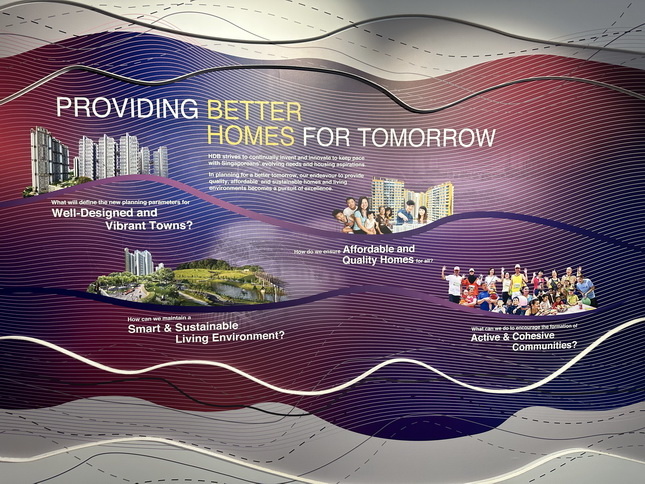•
已完成超过100万个单位
over 1 million units
•
已为国民提供住屋超过50年。打造了24个市镇及3个小区-
24 districts and 3 areas
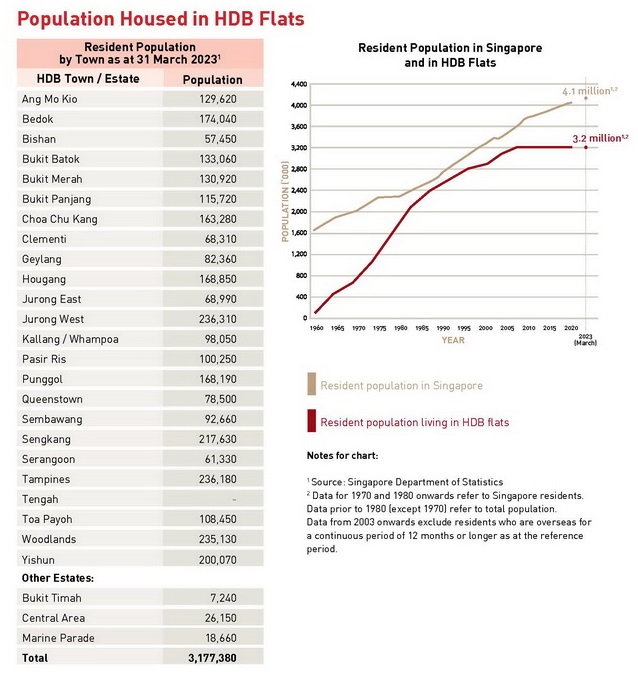
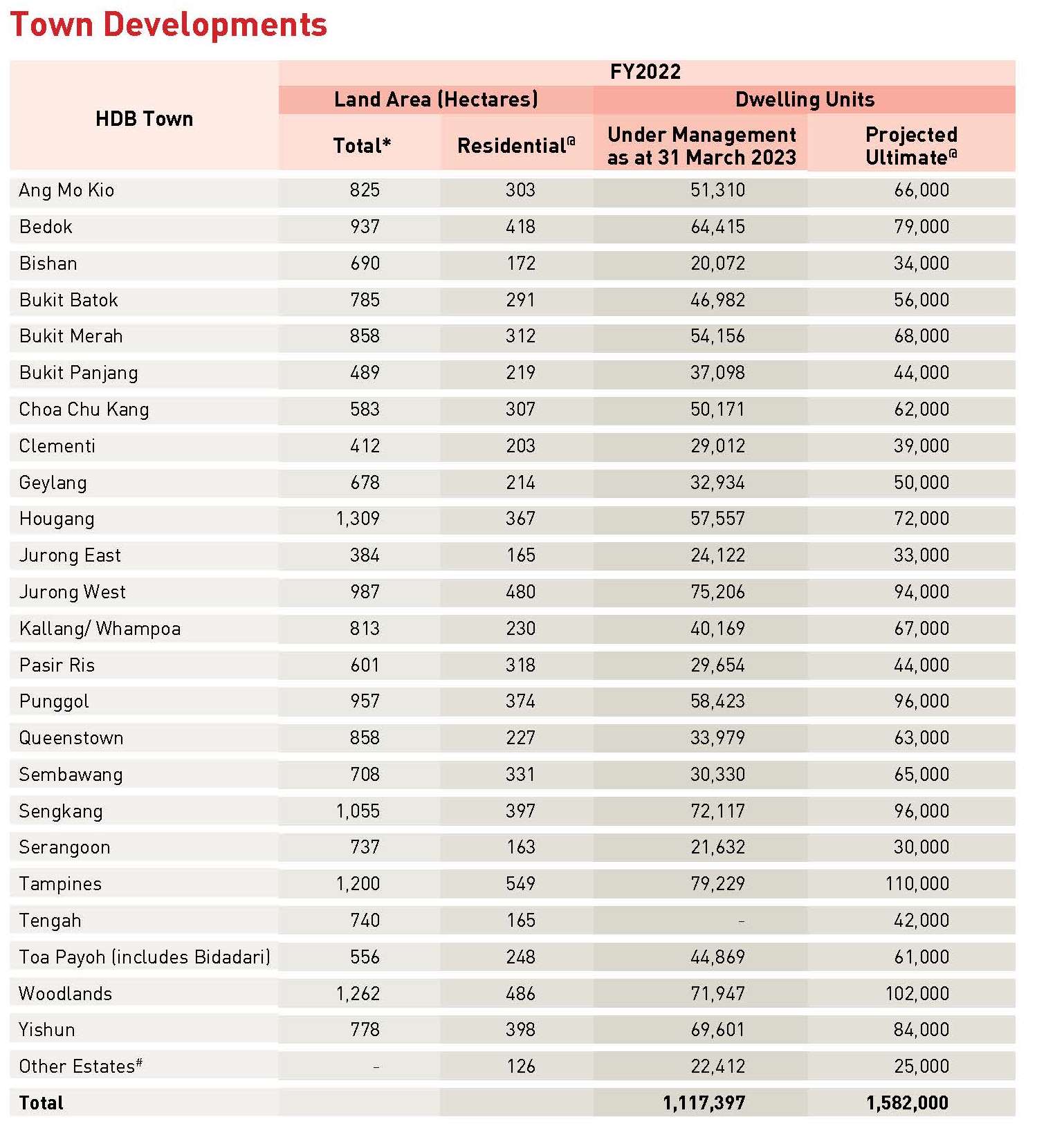

人民地方观感
(People
Place
Perception)
建屋局的故事,并不单单是—砖—瓦所建成的家,而是全岛新加坡人安居的故事。

建屋局的发展历程
(Journey)
从庇护所到家
(From Shelter
to
Home) --'居者有其屋的梦想。
|
|
|
In the 1960s, the Housing & Development Board (HDB) of
Singapore played a crucial role in transforming the
country’s housing landscape. This period was marked by
several key trends and developments:
1. Addressing the Housing Crisis
-
Severe Shortage of Housing:
In the early 1960s, Singapore faced an acute housing
shortage, with a large portion of the population living
in overcrowded, poorly built slums and squatter
settlements. The HDB was established in 1960 with the
primary goal of addressing this crisis.
-
Mass Construction of Public Housing:
The HDB's primary task was to build affordable and
high-quality public housing at a rapid pace. In its
first five years, the HDB constructed over 50,000
flats, a remarkable achievement for the time. This
aggressive building plan helped to drastically reduce
the housing shortfall.
2. Focus on Basic, Affordable Housing
-
Simple, Functional Flats:
HDB flats in the 1960s were basic but functional, often
in the form of small one- or two-room units. The main
focus was on providing shelter and basic amenities, such
as running water and electricity, to as many people as
possible.
-
Affordable Prices:
These flats were sold at affordable prices to cater to
the low- and middle-income population, making
homeownership accessible to many.
3. Urbanization and Town Planning
-
Satellite Towns Development:
The HDB introduced the concept of self-contained
satellite towns to decentralize housing away from the
city center. Towns like Queenstown, Toa Payoh, and
Bukit Ho Swee were developed, with each area
featuring amenities like schools, markets, and
healthcare centers, creating well-rounded communities.
-
New Town Planning:
A structured town planning approach was adopted to
organize housing estates. This included zoning for
residential, commercial, and recreational spaces, along
with accessible transport networks to connect residents
to the city center.
4. Rapid Industrialization and Housing as a Tool for Nation
Building
-
Economic and Social Stability:
Housing was seen not just as a social necessity but also
as a means to support Singapore's rapid
industrialization efforts. Providing decent housing for
workers enabled the government to reduce social tensions
and build a stable, productive labor force.
-
Homeownership as a National Goal:
Homeownership was promoted as a way to foster social
cohesion and a sense of national identity. The Central
Provident Fund (CPF) was introduced in 1968, allowing
Singaporeans to use their CPF savings to buy HDB flats,
creating a pathway to affordable homeownership.
5. Resettlement and Slum Clearance
-
Large-Scale Resettlement:
As part of the effort to clear slums and improve living
conditions, many residents were relocated from squatter
settlements to newly constructed HDB flats. This was a
significant social shift as thousands of families moved
from kampongs (villages) to high-rise apartments.
-
Social Engineering:
The resettlement process was not just about housing but
also about integrating different racial groups into
shared spaces. HDB’s ethnic integration policy
(introduced later, in the 1980s) began to take root,
promoting racial harmony by ensuring a balanced ethnic
mix in housing estates.
6. Foundation of HDB’s Reputation
-
Success in Alleviating the Housing Shortage:
By the end of the 1960s, the HDB had gained a strong
reputation for its efficiency in alleviating Singapore’s
housing shortage. It became a model for other countries
looking to address similar urban housing challenges.
In summary, the 1960s were a foundational period for HDB and
public housing in Singapore. The key trends during this
time—rapid housing construction, affordable pricing,
resettlement from slums, satellite town planning, and the
promotion of homeownership—set the stage for Singapore's
future housing policies and urban development.
 |
20
世纪
60
年代,新加坡建屋发展局 (HDB)
在改变该国住房格局方面发挥了至关重要的作用。这一时期出现了几个关键趋势和发展:
1.
解决住房危机
•
住房严重短缺:20
世纪
60
年代初,新加坡面临严重的住房短缺问题,大部分人口居住在拥挤不堪、建筑质量差的贫民窟和棚户区。建屋发展局成立于
1960
年,主要目标就是解决这一危机。
•
大规模建设公共住房:建屋发展局的主要任务是快速建设价格合理、质量上乘的公共住房。在建屋发展局成立后的头五年,建屋发展局建造了
50,000
多套公寓,这在当时是一项了不起的成就。这项积极的建设计划有助于大幅减少住房短缺问题。
2.
注重基本、可负担住房
•
简单、实用的公寓:20
世纪
60 年代的
HDB 公寓虽然简单但实用,通常为小型一室或两室单位。主要重点是为尽可能多的人提供住房和基本便利设施,如自来水和电力。
•
价格实惠:这些公寓以实惠的价格出售,以满足中低收入人群的需求,使许多人都能拥有住房。
3.
城市化和城镇规划
•
卫星城镇发展:HDB
引入了自给自足的卫星城镇概念,将住房分散到远离市中心的地方。皇后镇、大巴窑和河水山等城镇得到了发展,每个地区都设有学校、市场和医疗中心等便利设施,创造了全面的社区。
•
新城镇规划:采用结构化的城镇规划方法来组织住宅区。这包括划分住宅、商业和娱乐空间,以及连接居民和市中心的便捷交通网络。
4.
快速工业化和住房作为国家建设的工具
•
经济和社会稳定:住房不仅被视为社会必需品,也是支持新加坡快速工业化努力的一种手段。为工人提供体面的住房使政府能够缓解社会紧张局势并建立一支稳定、高效的劳动力队伍。
•
房屋所有权作为国家目标:房屋所有权被推广为促进社会凝聚力和民族认同感的一种方式。中央公积金
(CPF)
于 1968
年推出,允许新加坡人使用他们的公积金储蓄购买 HDB
公寓,为负担得起的房屋所有权开辟了道路。
5.
重新安置和贫民窟清理
•
大规模重新安置:作为清理贫民窟和改善生活条件的努力的一部分,许多居民从棚户区搬迁到新建的
HDB
公寓。这是一次重大的社会转变,因为成千上万的家庭从甘榜(村庄)搬到了高层公寓。 |
|
|
| |
|
|
|
|
In the 1970s, the Housing & Development Board (HDB) of
Singapore continued its mission to provide affordable public
housing, with several key initiatives that shaped the
nation’s urban landscape. This period saw the expansion of
housing efforts, focusing on improving living conditions and
supporting the country's rapid modernization. Below are some
of the key initiatives and trends from that era:
1. Expansion of Satellite Towns
-
Development of New Towns:
In the 1970s, the HDB continued its strategy of building
self-contained satellite towns to decentralize the
population from the city center. Towns such as Ang Mo
Kio, Bedok, and Clementi were developed during this
period. These towns were designed with a variety of
facilities like schools, parks, shops, and healthcare
services, creating a complete living environment.
-
Ang Mo Kio as a Model New Town:
Ang Mo Kio, launched in 1973, became a model for HDB
town planning. The town was built with a clear
organizational structure of neighborhoods, with each
precinct having access to amenities. It was one of the
first towns designed with high-rise buildings and more
advanced urban planning concepts.
2. Home Ownership for the People Scheme
-
Promotion of Homeownership:
One of the most significant initiatives of the 1970s was
the expansion of the Home Ownership for the People
Scheme, introduced in 1964. The scheme allowed
Singaporeans to use their Central Provident Fund (CPF)
savings to buy HDB flats. By the 1970s, the government
strongly encouraged homeownership, with the goal of
creating a nation of homeowners, which was seen as a way
to foster stability, social cohesion, and individual
financial security.
-
Wider Flat Types:
During this time, the range of flat types was expanded
to cater to different income groups. Besides the
standard two-room and three-room flats, larger four- and
five-room flats were introduced, allowing more space for
growing families and the middle-income population.
3. Introduction of the Residential Upgrading Program
-
Upgrading of Older Flats:
By the 1970s, some of the earlier HDB flats built in the
1960s were beginning to show signs of wear and tear. To
address this, the HDB began upgrading these flats to
improve living standards. This included structural
repairs, better sanitation, and the addition of modern
amenities like lifts and improved electrical systems.
-
Improved Design and Comfort:
The design of HDB flats evolved during this period to
provide better living conditions. Flats became more
spacious, with more modern facilities such as built-in
kitchens and larger windows for better ventilation.
Housing estates also became more aesthetically pleasing,
with more greenery and open spaces.
4. Town Planning and Improved Infrastructure
-
Comprehensive Urban Planning:
The 1970s saw more sophisticated urban planning in HDB
towns, with a greater emphasis on infrastructure and
transportation. Town centers were designed as hubs for
commercial activities, surrounded by residential blocks.
Public transport systems, including bus terminals, were
integrated into new town designs, ensuring that
residents had easy access to the city center.
-
First MRT Planning:
Though the Mass Rapid Transit (MRT) system was only
launched in the 1980s, planning for Singapore’s rail
network began in the 1970s. HDB towns developed in this
period were designed with future MRT connectivity in
mind, anticipating the need for efficient public
transport to serve a growing population.
5. Ethnic Integration Policy
-
Racial Integration:
Although formally introduced in the 1980s, the
foundation for the Ethnic Integration Policy was
laid in the 1970s. HDB was already conscious of
promoting social harmony in a multi-racial society. The
policy aimed to ensure a balanced ethnic mix in housing
estates, preventing ethnic enclaves and encouraging
racial integration. This was a step toward fostering
racial harmony through shared public spaces and
facilities in housing estates.
6. Focus on Community and Social Development
-
Community Facilities:
In addition to housing, the HDB placed greater emphasis
on developing community facilities to enhance the
quality of life. This included the construction of
markets, hawker centers, community centers, schools,
playgrounds, and places of worship within estates,
creating a vibrant community environment.
-
Promoting Social Cohesion:
The development of these facilities encouraged social
interaction among residents, fostering a sense of
belonging and community in HDB towns. The government
also promoted national identity and civic pride through
community programs, helping residents feel more
connected to the nation’s progress.
7. Industrial and Commercial Integration
-
Integration of Industry and Housing:
In the 1970s, the HDB began to integrate light
industrial developments into housing estates, bringing
jobs closer to residential areas. This initiative
supported Singapore’s industrialization efforts and
helped reduce commuting times for workers.
-
Development of Commercial Hubs:
Alongside residential flats, HDB developed commercial
spaces like shops, food courts, and offices within
housing estates. Town centers were designed as mixed-use
areas, allowing residents to live, work, and play within
their neighborhoods.
8. Focus on Larger Families
-
Larger Flat Sizes:
During this period, the focus shifted to accommodating
larger families. The introduction of four- and five-room
flats was a response to the growing needs of
multi-generational families, providing them with more
living space and flexibility.
In summary, the 1970s was a decade of consolidation and
expansion for HDB. The key initiatives during this period
focused on the development of new satellite towns, promoting
homeownership, improving infrastructure, enhancing living
conditions through upgrading programs, and fostering social
integration. These efforts laid the groundwork for the
comprehensive and efficient public housing system that would
continue to evolve in the decades to come.
 |
20 世纪 70
年代,新加坡建屋局 (HDB)
继续履行提供可负担公共住房的使命,并采取了多项关键举措,塑造了该国的城市面貌。这一时期,住房工作得到扩大,重点是改善生活条件和支持该国的快速现代化。以下是那个时代的一些关键举措和趋势:
1. 卫星城扩张
• 新城发展:20 世纪 70
年代,建屋局继续实施建设自给自足的卫星城的战略,以将人口从市中心分散开来。宏茂桥、勿洛和金文泰等城镇在此期间得到发展。这些城镇设计了各种设施,如学校、公园、商店和医疗保健服务,创造了一个完整的生活环境。
• 宏茂桥作为模范新城:宏茂桥于 1973
年推出,成为建屋局城镇规划的典范。该镇的社区组织结构清晰,每个区域都可以使用便利设施。它是首批采用高层建筑和更先进的城市规划理念设计的城镇之一。
2. 人民拥有房屋计划
• 促进房屋所有权:20 世纪 70 年代最重要的举措之一是扩大 1964
年推出的人民拥有房屋计划。该计划允许新加坡人使用他们的中央公积金 (CPF) 储蓄购买 HDB 公寓。到 20 世纪
70 年代,政府大力鼓励房屋所有权,目标是建立一个房主国家,这被视为促进稳定、社会凝聚力和个人财务安全的一种方式。
•
更广泛的公寓类型:在此期间,公寓类型的范围得到扩大,以满足不同收入群体的需求。除了标准的两室和三室公寓外,还引入了更大的四室和五室公寓,为成长中的家庭和中等收入人群提供了更多空间。
3. 住宅升级计划的引入
• 旧公寓升级:到 20 世纪 70 年代,一些建于 20 世纪 60 年代的早期 HDB
公寓开始出现磨损迹象。为了解决这个问题,HDB
开始升级这些公寓,以提高生活水平。这包括结构维修、改善卫生条件以及增加电梯和改进电气系统等现代化设施。
• 改进设计和舒适度:HDB
公寓的设计在此期间不断发展,以提供更好的生活条件。公寓变得更加宽敞,拥有更多现代化设施,例如内置厨房和更大的窗户,以便更好地通风。住宅区也变得更加美观,拥有更多的绿化和开放空间。
4. 城镇规划和改善基础设施
• 全面的城市规划:20 世纪 70 年代,HDB
城镇的城市规划更加复杂,更加重视基础设施和交通。城镇中心被设计为商业活动中心,周围环绕着住宅区。公共交通系统(包括巴士总站)被整合到新城镇设计中,确保居民可以轻松前往市中心。
• 第一个地铁规划:虽然大众捷运(MRT)系统直到 20 世纪 80 年代才推出,但新加坡的铁路网络规划始于 20 世纪
70 年代。在此期间开发的 HDB 城镇在设计时考虑到了未来的地铁连通性,预计需要高效的公共交通来服务不断增长的人口。
5. 民族融合政策
• 种族融合:虽然民族融合政策在 20 世纪 80 年代正式推出,但其基础是在 20 世纪 70
年代奠定的。建屋局已经意识到在多种族社会中促进社会和谐。该政策旨在确保住宅区内种族平衡,防止种族聚居,并鼓励种族融合。这是通过共享住宅区公共空间和设施促进种族和谐的一步。
6. 注重社区和社会发展
•
社区设施:除了住房,建屋局还更加重视发展社区设施,以提高生活质量。这包括在屋邨内兴建市场、小贩中心、社区中心、学校、游乐场和礼拜场所,营造充满活力的社区环境。
•
促进社会凝聚力:这些设施的发展鼓励居民之间的社交互动,培养建屋局城镇的归属感和社区意识。政府还通过社区计划促进国家认同和公民自豪感,帮助居民感受到与国家进步的紧密联系。
7. 工业和商业融合
• 工业和住房融合:20 世纪 70
年代,建屋局开始将轻工业发展融入住宅区,使工作地点更接近住宅区。这一举措支持了新加坡的工业化努力,并有助于减少工人的通勤时间。
|
|
|
In the 1980s, the Housing &
Development Board (HDB) of Singapore continued to expand its
public housing program with several key initiatives and
developments that improved housing affordability, community
planning, and living standards. This decade marked a
significant shift towards upgrading existing infrastructure,
promoting racial harmony, and enhancing homeownership. Here
are the major initiatives and developments in the 1980s:
1. Introduction of the Ethnic Integration Policy (EIP)
- Fostering Racial Harmony: One of
the most significant initiatives in the 1980s was the
introduction of the Ethnic Integration Policy (EIP)
in 1989. This policy set quotas for the ethnic
composition of residents in HDB estates, ensuring that
no racial group would dominate a neighborhood. The goal
was to prevent ethnic enclaves and promote interaction
among different races, fostering social cohesion and
national unity in Singapore's multi-ethnic society.
- Balanced Racial Distribution: Under
the EIP, specific limits were imposed on the percentage
of flats in an estate that could be allocated to each
ethnic group. This policy played a crucial role in
strengthening social integration, as Singaporeans from
various ethnic backgrounds would live side by side,
encouraging a sense of community and understanding.
2. Launch of the Selective En bloc Redevelopment
Scheme (SERS)
- Urban Renewal and Redevelopment:
The Selective En bloc Redevelopment Scheme (SERS),
introduced in 1989, was aimed at rejuvenating older
estates. Under this scheme, certain older HDB blocks
were demolished, and the land was redeveloped to create
new, modern housing. Affected residents were offered new
flats in nearby areas, often with better amenities and
higher property values.
- Maximizing Land Use: SERS allowed
the HDB to better utilize land in older estates that
were underdeveloped or aging. This not only provided
newer, better flats for residents but also made room for
additional housing to meet growing demand in mature
towns.
3. Expansion of the Home Ownership Scheme
- Promotion of Homeownership: In the
1980s, the HDB expanded the Home Ownership for
the People Scheme to further encourage
Singaporeans to purchase their own homes. The government
continued to offer subsidies and grants to make flats
affordable for a wider range of income groups. The use
of Central Provident Fund (CPF) savings
for down payments and mortgage repayments also became
more widespread during this time.
4. Upgrading and Modernization of Older Estates
- Home Improvement Program (HIP): The
Home Improvement Program (HIP),
introduced in the late 1980s, focused on upgrading older
HDB flats to modern standards. Improvements included
upgrading toilets, rewiring electrical systems, and
installing new windows. This program aimed to enhance
the safety, comfort, and aesthetic appeal of aging
flats.
- Lift Upgrading Program (LUP): A key
part of the modernization efforts was the Lift
Upgrading Program (LUP), which ensured that
every HDB block had lifts that stopped at every floor.
This initiative was particularly important for the
elderly and residents with mobility issues, improving
accessibility and convenience.
- Precinct Upgrading: Beyond
individual flats, entire precincts were also upgraded.
This involved improving common spaces such as
playgrounds, walkways, and landscaped areas to create a
better living environment for residents.
5. More Varied Flat Types and Designs
- New Flat Designs: In the 1980s, HDB
introduced more varied flat types and designs to cater
to the changing needs and aspirations of Singaporeans.
Larger flats, such as four-room and five-room units,
became more common, and flat designs were improved to
include better ventilation, larger kitchens, and
balconies.
- Maisonettes and Executive Apartments:
During this period, HDB also introduced maisonettes and
executive apartments, which were two-story units that
offered more living space and were aimed at the
higher-income bracket. These flats were seen as a bridge
between public housing and private property, allowing
residents to enjoy more luxurious living spaces at
affordable prices.
6. Focus on Community and Social Infrastructure
- Development of Town Centers: The
1980s saw a greater emphasis on developing comprehensive
town centers within HDB estates. These centers were
designed to be the commercial and social hubs of new
towns, featuring shopping malls, hawker centers,
libraries, and recreational facilities. This was part of
the government’s vision of creating self-contained
communities where residents could live, work, and play
without needing to travel far.
- Integrated Amenities: In addition
to town centers, HDB developments in the 1980s included
a greater variety of amenities, such as parks, schools,
and healthcare facilities, all within walking distance
of residential areas. This integrated approach to
planning enhanced the quality of life for residents and
strengthened the sense of community within HDB estates.
7. Land Optimization and High-Rise Living
- Shift Toward High-Density Housing:
As land scarcity became a pressing issue in Singapore,
the HDB focused on maximizing the use of available land
by building more high-rise flats. Taller HDB blocks were
constructed to accommodate more residents, especially in
mature estates where land was limited.
- Land Intensification: To ensure
that Singapore's limited land resources were used
efficiently, the HDB worked closely with urban planners
to create high-density towns that could accommodate more
people while maintaining a high standard of living.
8. Environmental and Sustainability Efforts
- Green Spaces and Environmental Planning:
The HDB began incorporating more green spaces and
environmentally friendly features into its estate
designs. Parks, playgrounds, and community gardens were
integrated into housing estates to improve residents'
well-being and promote sustainable living.
- Energy Efficiency: The 1980s also
saw the introduction of energy-saving measures, such as
better insulation in flats and the use of more efficient
water and electrical systems. While these efforts were
modest compared to later decades, they marked the
beginning of HDB’s commitment to sustainability.
9. Housing Loan Policies and Subsidies
- HDB Loans and Housing Grants: In
the 1980s, the HDB provided loans at subsidized interest
rates to help lower-income families afford homes.
Additionally, housing grants were introduced to help
young couples and first-time buyers purchase flats at
more affordable rates. These policies made it easier for
Singaporeans to achieve homeownership, regardless of
their financial situation.
In summary, the 1980s were a transformative decade for
Singapore's public housing sector. The key initiatives
included the Ethnic Integration Policy to promote social
harmony, the introduction of SERS to rejuvenate older
estates, and the expansion of homeownership schemes. At the
same time, HDB flats were upgraded and modernized, new town
centers were developed, and high-rise, high-density living
became more common. These initiatives laid the foundation
for the continued success of Singapore's public housing
model, ensuring that it remained affordable, inclusive, and
sustainable.
 |
20 世纪 80
年代,新加坡建屋发展局 (HDB)
继续扩大公共住房计划,推出了多项重要举措和发展,改善了住房负担能力、社区规划和生活水平。这十年标志着向升级现有基础设施、促进种族和谐和提高房屋所有权的重大转变。以下是
20 世纪 80 年代的主要举措和发展:
1. 引入种族融合政策 (EIP)
促进种族和谐:20 世纪 80 年代最重要的举措之一是 1989 年引入的种族融合政策 (EIP)。该政策为建屋发展局
(HDB)
住宅区的居民种族构成设定了配额,确保没有任何种族群体主导社区。目标是防止种族聚居区并促进不同种族之间的互动,促进新加坡多民族社会的社会凝聚力和民族团结。
平衡种族分布:根据 EIP,对一个庄园中分配给每个种族群体的单位百分比施加了特定限制。这项政策在加强社会融合方面发挥了至关重要的作用,因为来自不同种族背景的新加坡人将生活在一起,鼓励社区意识和理解。
2. 推出选择性整体重建计划 (SERS)
城市更新和重建:选择性整体重建计划 (SERS) 于 1989 年推出,旨在振兴旧庄园。根据该计划,某些较旧的 HDB
街区被拆除,土地被重新开发以建造新的现代化住房。受影响的居民可以在附近地区获得新公寓,这些公寓通常具有更好的设施和更高的房产价值。
最大限度地利用土地:SERS 使 HDB
能够更好地利用开发不足或老化的旧庄园中的土地。这不仅为居民提供了更新、更好的公寓,而且还为额外的住房腾出了空间,以满足成熟城镇日益增长的需求。
3. 扩大房屋所有权计划
促进房屋所有权:20 世纪 80
年代,建屋局扩大了全民房屋所有权计划,进一步鼓励新加坡人购买自己的房屋。政府继续提供补贴和补助,使更多收入群体都能买得起公寓。在此期间,使用中央公积金
(CPF) 储蓄支付首付和抵押贷款也变得更加普遍。。
4. 旧屋的升级和现代化
家居改造计划 (HIP):家居改造计划 (HIP) 于 20 世纪 80 年代末推出,重点是将旧 HDB
公寓升级到现代标准。改造包括升级厕所、重新布线电气系统和安装新窗户。该计划旨在提高老旧公寓的安全性、舒适性和美观性。
电梯升级计划 (LUP):现代化工作的一个关键部分是电梯升级计划 (LUP),该计划确保每个 HDB
街区都有停在每一层楼的电梯。这项举措对老年人和行动不便的居民尤其重要,提高了可达性和便利性。
小区升级:除了单个公寓外,整个小区也进行了升级。这涉及改善游乐场、人行道和景观区等公共空间,为居民创造更好的生活环境。
5. 更加多样化的公寓类型和设计
新公寓设计:20 世纪 80
年代,建屋局推出了更加多样化的公寓类型和设计,以满足新加坡人不断变化的需求和愿望。四房和五房等大型公寓变得越来越普遍,公寓设计也得到了改进,包括更好的通风、更大的厨房和阳台。
复式公寓和行政公寓:在此期间,建屋局还推出了复式公寓和行政公寓,这些公寓是两层楼的单元,提供更多的居住空间,针对高收入阶层。这些公寓被视为公共住房和私人财产之间的桥梁,让居民以实惠的价格享受更豪华的居住空间。
6. 关注社区和社会基础设施
城镇中心的发展:20 世纪 80
年代,建屋局更加重视在建屋局的庄园内开发综合城镇中心。这些中心旨在成为新城镇的商业和社交中心,设有购物中心、小贩中心、图书馆和娱乐设施。这是政府创建自给自足社区愿景的一部分,居民无需远行即可生活、工作和娱乐。
综合设施:除了城镇中心,20 世纪 80 年代的 HDB
开发项目还包括更多种类的设施,如公园、学校和医疗保健设施,所有这些都在步行距离内。这种综合规划方法提高了居民的生活质量,增强了
HDB 区内的社区意识。
7. 土地优化和高层生活
向高密度住房转变:随着土地稀缺成为新加坡的一个紧迫问题,HDB
专注于通过建造更多高层公寓来最大限度地利用可用土地。为了容纳更多居民,建屋局建造了更高的楼宇,尤其是在土地有限的成熟小区。
土地集约化:为了确保有效利用新加坡有限的土地资源,建屋局与城市规划人员密切合作,创建高密度城镇,在保持高生活水平的同时容纳更多人。
8. 环境和可持续发展工作
绿地和环境规划:建屋局开始将更多绿地和环保设施纳入其小区设计中。公园、游乐场和社区花园被整合到住宅小区中,以改善居民的福祉并促进可持续生活。
能源效率:20 世纪 80
年代还引入了节能措施,例如改善公寓的隔热性能并使用更高效的水电系统。虽然与后来的几十年相比,这些努力微不足道,但它们标志着建屋局致力于可持续发展的开始。
9. 住房贷款政策和补贴
建屋局贷款和住房补助金:20 世纪 80
年代,建屋局以补贴利率提供贷款,帮助低收入家庭买得起房子。此外,还推出了住房补助金,帮助年轻夫妇和首次购房者以更实惠的价格购买公寓。这些政策使新加坡人无论经济状况如何,都能更轻松地拥有住房。
总之,20 世纪 80 年代是新加坡公共住房部门的变革十年。关键举措包括促进社会和谐的种族融合政策、引入 SERS
以振兴旧区以及扩大房屋所有权计划。与此同时,建屋局的公寓得到了升级和现代化改造,新的城镇中心得到了开发,高层高密度生活变得更加普遍。这些举措为新加坡公共住房模式的持续成功奠定了基础,确保了其价格实惠、包容性和可持续性。
|
|
|
|
In the 1990s, the Housing & Development Board (HDB) of
Singapore continued to innovate and adapt its public housing
policies and initiatives to meet the evolving needs of the
population. During this period, there was a strong focus on
enhancing the quality of life in HDB estates, modernizing
housing infrastructure, and creating more opportunities for
homeownership. Here are the key initiatives and developments
of the HDB in the 1990s:
1. Introduction of the Executive Condominium Scheme (EC)
-
Bridging the Gap Between Public and Private Housing:
Introduced in 1995, the Executive Condominium (EC)
Scheme was designed to cater to the "sandwiched
class"—Singaporeans whose income exceeded the
eligibility limits for standard HDB flats but who could
not afford private property. ECs offered
condominium-style living (with facilities like swimming
pools, gyms, and security) but were priced lower than
private condos.
-
Subsidized Ownership with Private Market Potential:
EC buyers enjoyed subsidies and could use their Central
Provident Fund (CPF) savings to finance their purchase.
After a minimum occupation period of 5 years, ECs could
be sold on the open market, making them attractive to
families aspiring for private homeownership in the long
term.
2. Selective En bloc Redevelopment Scheme (SERS) Expansion
-
Urban Renewal and Rejuvenation of Older Estates:
The Selective En bloc Redevelopment Scheme (SERS),
introduced in the late 1980s, gained momentum in the
1990s. SERS aimed to redevelop older HDB blocks,
particularly those in prime locations, to optimize land
use and provide residents with new, modern flats.
-
Relocation and Compensation for Affected Residents:
Under SERS, residents were offered new, better-quality
flats, often in nearby areas, along with generous
compensation. This ensured minimal disruption to
communities and maintained the continuity of social
networks.
3. Estate Upgrading Program (EUP)
-
Improving the Quality of Older HDB Estates:
The Estate Upgrading Program (EUP) was launched
in the 1990s to enhance the living environment in older
estates that were not included in SERS. EUP focused on
upgrading common facilities, improving accessibility,
and beautifying the surroundings. This included the
renovation of void decks, the installation of new
playgrounds, landscaping, and upgrading utilities.
-
Community-Centered Improvements:
The program also introduced community-based
improvements, such as senior-friendly infrastructure
(e.g., ramps, handrails) and upgraded sports and
recreational facilities to meet the changing needs of
residents.
4. Home Improvement Program (HIP)
-
Upgrading Inside Homes:
The Home Improvement Program (HIP), which began
in the late 1980s, continued in the 1990s with a focus
on upgrading the interiors of aging HDB flats. Key
improvements included renovations of bathrooms,
replacement of windows, upgrading of electrical wiring,
and other structural repairs to ensure that older flats
remained safe and comfortable for residents.
-
Elder-Friendly Modifications:
As Singapore's population aged, the HIP included
provisions for elder-friendly home modifications, such
as grab bars, non-slip flooring, and ramps, making homes
more accessible for the elderly.
5. Lift Upgrading Program (LUP)
-
Increasing Accessibility:
One of the most important initiatives of the 1990s was
the continued rollout of the Lift Upgrading Program (LUP).
This program ensured that lifts in older HDB blocks were
upgraded to stop at every floor, significantly improving
accessibility for residents, especially the elderly and
those with mobility issues.
-
Enhanced Safety and Convenience:
The LUP also included the installation of new, safer,
and more energy-efficient lifts in many older blocks,
improving convenience and quality of life for residents
in high-rise HDB flats.
6. Design and Build Scheme
-
Greater Customization for Homebuyers:
In the 1990s, HDB introduced the Design and Build
Scheme, which allowed private developers to design
and build HDB flats with greater flexibility in terms of
layout, design, and interior fittings. These projects
were typically more aesthetically pleasing and
incorporated more advanced architectural features,
offering residents a higher standard of living within
the public housing framework.
-
Partnership with Private Developers:
The scheme allowed private-sector architects and
contractors to bring innovation and creativity to HDB
developments, while HDB ensured affordability and
quality control. This partnership also led to greater
diversity in the design of HDB flats.
7. Launching the Central Provident Fund (CPF) Housing Grant
Scheme
-
Support for First-Time Buyers:
The CPF Housing Grant Scheme, introduced in 1994,
was a major initiative aimed at helping first-time
buyers afford HDB flats in the resale market. The
government provided cash grants (which could be used to
offset the flat’s cost) to lower- and middle-income
families who were buying resale flats, making it easier
for them to purchase a home.
-
Encouraging Resale Market Activity:
The scheme also helped boost activity in the resale HDB
market, giving buyers more options in terms of location
and flat type. This, in turn, helped to alleviate some
of the pressure on new flat demand.
8. New Town Development and Expansion of Existing Estates
-
Development of New Towns:
HDB continued to develop new towns in the 1990s, with
Sengkang and Punggol being key examples.
These new towns were built with a comprehensive range of
amenities and facilities, including schools, parks,
community centers, and commercial hubs, creating
self-sufficient communities.
-
Expansion of Existing Estates:
In addition to new towns, the 1990s saw the expansion of
older estates like Tampines and Yishun.
HDB redeveloped underutilized land in these areas to
accommodate more flats, meeting the growing demand for
public housing.
9. Greater Focus on Town Planning and Environmental
Sustainability
-
Integrated Town Planning:
In the 1990s, HDB adopted a more holistic approach to
town planning, focusing on creating well-rounded,
self-sufficient communities. This meant integrating
residential, commercial, and recreational spaces within
each town, ensuring that residents had access to all the
necessary amenities without needing to travel far.
-
Environmental Sustainability:
There was also a growing focus on sustainability in HDB
developments during the 1990s. HDB began incorporating
more greenery into its estates, building parks and
community gardens, and using environmentally friendly
building materials. Energy-saving measures, such as
improved ventilation and lighting designs, were
introduced in new HDB blocks to reduce energy
consumption.
10. Introduction of the Housing Maintenance and Management
Policies
-
Maintenance of HDB Flats:
As HDB estates aged, the board placed greater emphasis
on the maintenance and management of flats. In the
1990s, HDB set up management committees and established
service standards for the upkeep of public spaces,
including cleaning, landscaping, and repairs.
-
Town Councils:
The Town Councils Act, passed in 1989, began to
have a greater impact in the 1990s. Town councils,
composed of elected local representatives, were
responsible for maintaining the common areas of HDB
estates, giving residents more control over the
management of their towns.
11. Introduction of the Premium Flats
-
More Upscale Housing Options:
To cater to rising aspirations, HDB introduced
Premium Flats in the 1990s. These flats featured
better finishes, larger spaces, and were located in
prime areas or near town centers. Premium Flats were
aimed at middle-income families looking for
higher-quality public housing options without entering
the private property market.
12. HDB’s First Smart Estate Initiatives
-
Digital and Technological Innovations:
The 1990s saw the early stages of smart estate
initiatives by HDB, with the incorporation of
technologies like closed-circuit television (CCTV) for
better estate security and the installation of
electronic parking systems. This period laid the
foundation for future "smart towns" that would
incorporate more advanced technologies in housing
developments.
In summary, the 1990s were a period of significant expansion
and modernization for Singapore's HDB. The key initiatives
focused on improving the quality of housing, expanding
homeownership opportunities, rejuvenating older estates, and
ensuring that public housing met the evolving needs of
Singaporeans. The decade also laid the groundwork for more
integrated town planning and future sustainability efforts,
positioning HDB to continue providing affordable,
high-quality homes for the growing population.
 |
20
世纪 90
年代,新加坡建屋发展局 (HDB)
不断创新和调整公共住房政策和举措,以满足人口不断变化的需求。在此期间,重点关注提高
HDB
区的生活质量、现代化住房基础设施以及创造更多购房机会。以下是
HDB
在 20
世纪
90
年代的主要举措和发展:
1.
推出行政公寓计划 (EC)
缩小公共住房和私人住房之间的差距:行政公寓计划
(EC)
于 1995
年推出,旨在满足“夹心阶层”的需求——收入超过标准 HDB
公寓资格限制但买不起私人房产的新加坡人。EC
提供公寓式生活(配有游泳池、健身房和安保等设施),但价格低于私人公寓。
具有私人市场潜力的补贴所有权:EC
买家享受补贴,并可以使用中央公积金
(CPF)
储蓄来支付购房费用。EC
至少居住 5
年后可在公开市场上出售,这对希望长期拥有私人住房的家庭来说具有吸引力。
2.
选择性整体重建计划
(SERS)
扩展
旧区城市更新和复兴:选择性整体重建计划
(SERS)
于 1980
年代末推出,在 1990
年代发展势头强劲。SERS
旨在重建较旧的
HDB
街区,特别是那些位于黄金地段的街区,以优化土地利用并为居民提供新的现代化公寓。
受影响居民的搬迁和补偿:根据 SERS,居民通常可以获得位于附近地区的新的、质量更好的公寓,以及丰厚的补偿。这确保了对社区的干扰最小,并保持了社会网络的连续性。
3.
住宅区升级计划 (EUP)
改善旧
HDB
住宅区的质量:住宅区升级计划
(EUP)
于 20
世纪
90
年代启动,旨在改善未纳入
SERS
的旧住宅区的生活环境。EUP
专注于升级公共设施、改善可达性和美化周围环境。这包括翻新空地、安装新游乐场、美化环境和升级公用设施。
以社区为中心的改进:该计划还引入了以社区为基础的改进,例如老年人友好型基础设施(例如坡道、扶手)和升级的体育和娱乐设施,以满足居民不断变化的需求。
4.
家居改善计划 (HIP)
升级住宅内部:家居改善计划 (HIP)
始于 20
世纪 80
年代末,在 20
世纪 90
年代继续实施,重点是升级老旧
HDB
公寓的内部。主要改进包括浴室翻新、窗户更换、电线升级和其他结构性维修,以确保老旧公寓对居民来说仍然安全舒适。
老年人友好型改造:随着新加坡人口老龄化,HIP
包括老年人友好型住宅改造,例如扶手、防滑地板和坡道,使老年人更容易进入住宅。
5.
电梯升级计划
(LUP)
提高可达性:20
世纪
90
年代最重要的举措之一是继续推出电梯升级计划 (LUP)。该计划确保较旧的
HDB
大楼的电梯升级到每层都停靠,大大提高了居民的可达性,尤其是老年人和行动不便的人。
增强安全性和便利性:LUP
还包括在许多旧大楼安装新的、更安全、更节能的电梯,提高高层
HDB
公寓居民的便利性和生活质量。
6.
设计与建造计划
为购房者提供更多定制化选择:20
世纪
90
年代,建屋局推出了设计与建造计划,允许私人开发商在布局、设计和室内装修方面更灵活地设计和建造建屋局公寓。这些项目通常更美观,并融入了更先进的建筑特色,在公共住房框架内为居民提供更高的生活水平。
与私人开发商的合作:该计划允许私营部门的建筑师和承包商为建屋局开发项目带来创新和创造力,而建屋局则确保价格合理和质量控制。这种合作关系也使建屋局公寓的设计更加多样化
7. 推出中央公积金 (CPF)
住房补助计划
• 为首次购房者提供支持:1994
年推出的中央公积金住房补助计划是一项重大举措,旨在帮助首次购房者在二手市场上购买
HDB
单位。政府向购买二手单位的中低收入家庭提供现金补助(可用于抵消单位成本),使他们更容易购买房屋。
• 鼓励二手市场活动:该计划还有助于促进二手
HDB
市场的活动,为买家提供更多位置和单位类型的选择。这反过来又有助于缓解新单位需求的一些压力。
8. 新城镇开发和现有庄园的扩建
• 新城镇开发:HDB
在 1990
年代继续开发新城镇,盛港和榜鹅就是典型例子。这些新城镇配备了全面的便利设施,包括学校、公园、社区中心和商业中心,形成了自给自足的社区。
• 现有社区的扩张:除了新城镇,20
世纪 90
年代还扩张了淡滨尼和义顺等老旧社区。建屋局重新开发了这些地区未充分利用的土地,以容纳更多公寓,满足了日益增长的公共住房需求。
9. 更加注重城镇规划和环境可持续性
• 综合城镇规划:20
世纪 90
年代,建屋局采用了更全面的城镇规划方法,专注于创建全面、自给自足的社区。这意味着整合每个城镇内的住宅、商业和娱乐空间,确保居民无需远行即可获得所有必要的便利设施。
• 环境可持续性:20
世纪 90
年代,建屋局也越来越注重可持续发展。建屋局开始在其屋邨内增加绿化,兴建公园和社区花园,并使用环保建筑材料。建屋局在新建的屋邨内引入节能措施,例如改善通风和照明设计,以减少能源消耗。
10. 房屋维修及管理政策的引入
• 建屋局单位维修:随着建屋局屋邨老化,董事会更加重视单位的维修和管理。20
世纪 90
年代,建屋局成立管理委员会,并制定公共空间保养服务标准,包括清洁、景观美化和维修。
• 市镇理事会:1989
年通过的《市镇理事会法》在 20
世纪 90
年代开始发挥更大作用。市镇理事会由民选地方代表组成,负责维护建屋局屋邨的公共区域,让居民对市镇的管理有更多掌控权。
11. 推出高级组屋
• 更多高档住房选择:为了满足日益增长的需求,建屋局在
20 世纪 90
年代推出了高级组屋。这些组屋装修更精致,空间更大,位于黄金地段或市中心附近。高级组屋面向中等收入家庭,他们希望获得更高质量的公共住房,而无需进入私人房地产市场。
12. 建屋局的首个智能地产计划
• 数字和技术创新:20
世纪 90
年代是建屋局智能地产计划的早期阶段,采用了闭路电视 (CCTV)
等技术来提高房地产安全性,并安装了电子停车系统。这一时期为未来的“智能城镇”奠定了基础,这些城镇将在住房开发中采用更先进的技术。
总之,20
世纪 90
年代是新加坡建屋局大规模扩张和现代化的时期。主要举措包括改善住房质量、扩大购房机会、翻新旧房,以及确保公共住房满足新加坡人不断变化的需求。这十年还为更综合的城镇规划和未来的可持续发展工作奠定了基础,使建屋局能够继续为不断增长的人口提供价格合理的高品质住房。
|
|
|
|
Between 2000 and 2009, the Housing & Development Board (HDB)
of Singapore introduced a range of key initiatives and
developments that focused on enhancing the quality of public
housing, improving sustainability, and offering more diverse
housing choices. These efforts reflected a maturing housing
market and the evolving aspirations of Singaporeans. Below
are the major initiatives and developments in this period:
1. Building-to-Order (BTO) Scheme (2001)
-
Introduction of the BTO System:
One of the most significant developments in the 2000s
was the launch of the Build-to-Order (BTO) Scheme
in 2001. This scheme replaced the previous system of
building flats in anticipation of demand. Under the BTO
system, flats were only built when there was sufficient
demand, based on confirmed bookings by potential buyers.
-
Flexibility in Planning:
The BTO system allowed HDB to better manage the supply
of flats and avoid an over-supply or under-supply of
housing units. It also provided flexibility in terms of
where flats were built, catering to varying demand
levels across different estates.
-
Longer Waiting Period:
While the BTO system was more efficient in terms of
resource use, it meant that potential homeowners had to
wait longer—typically 3 to 5 years—for their flats to be
completed. However, the system also ensured that flats
were built to meet real demand, minimizing waste and
controlling public housing supply.
2. Design, Build, and Sell Scheme (DBSS) (2005)
-
Public-Private Partnership for Housing:
The Design, Build, and Sell Scheme (DBSS),
launched in 2005, allowed private developers to design,
build, and sell HDB flats at market rates. These flats,
while part of the public housing system, were developed
with higher-quality finishes and more attractive designs
compared to standard HDB flats.
-
Increased Housing Variety:
The DBSS offered more choices to homebuyers looking for
higher-end HDB flats, and it provided an option between
traditional HDB flats and private condominiums. Although
they were more expensive than regular HDB flats, DBSS
flats were still subsidized by the government and
eligible for CPF housing grants.
3. Punggol 21 and Punggol 21+ Initiatives
-
Development of Punggol as a New Waterfront Town:
In the early 2000s, HDB focused on transforming
Punggol into a modern, waterfront town under the
Punggol 21 vision. This plan aimed to create a "New
Generation" HDB town with a waterfront living concept,
modern amenities, and extensive green spaces.
-
Punggol 21+ (2007):
Due to delays and changes in demand, the original plan
evolved into Punggol 21+, which was unveiled in
2007. This enhanced plan included the creation of more
waterfront homes, better public transport connectivity,
and a town center along the Punggol Waterway. Punggol
21+ was a key project that marked HDB's commitment to
providing residents with a high-quality living
environment, with an emphasis on lifestyle and leisure.
4. HDB Upgrading and Rejuvenation Programs
-
Continued Focus on Estate Renewal:
In the 2000s, HDB intensified efforts to upgrade and
rejuvenate older housing estates, ensuring they kept
pace with modern developments. Several key upgrading
programs were launched or expanded during this period.
-
Home Improvement Program (HIP):
Introduced in 2007, the Home Improvement Program
(HIP) replaced the earlier Main Upgrading Program (MUP).
HIP targeted essential improvements inside the flats,
such as bathroom upgrading, the replacement of waste
pipes, and enhancements to electrical systems. Residents
of older flats built before 1986 were eligible for the
program, and it was heavily subsidized by the
government.
-
Neighbourhood Renewal Program (NRP):
The Neighbourhood Renewal Program (NRP),
introduced in 2007, focused on common spaces and
facilities in older estates. This included the upgrading
of parks, playgrounds, and other communal areas, as well
as enhancing the estate’s aesthetic appeal. Unlike other
upgrading programs, the NRP was fully funded by the
government and did not require co-payment from
residents.
-
Lift Upgrading Program (LUP):
The Lift Upgrading Program (LUP), which began in
the 1990s, continued to be a major initiative throughout
the 2000s. By 2009, significant progress had been made
in ensuring that all eligible HDB blocks had lifts that
stopped at every floor, enhancing accessibility for the
elderly and those with mobility issues.
5. Introduction of Studio Apartments for the Elderly
-
Housing for an Aging Population:
With Singapore’s population aging, HDB introduced
Studio Apartments in 2000, designed specifically for
the elderly. These apartments were smaller, affordable,
and came with elder-friendly features, such as grab
bars, non-slip tiles, and emergency alert systems.
Located in mature estates with access to amenities,
these flats were designed to allow seniors to live
independently but comfortably in a safe environment.
-
Lease Terms and Affordability:
Studio Apartments were sold on 30-year leases (shorter
than the typical 99-year lease) to keep them affordable,
and buyers were provided with subsidies to make them
even more accessible to lower-income elderly residents.
6. Greater Focus on Environmental Sustainability
-
Green Mark Certification for Buildings:
In line with Singapore’s sustainability agenda, HDB
began incorporating eco-friendly designs and features in
its developments in the 2000s. The Green Mark
Certification, introduced by the Building and
Construction Authority (BCA), became a standard for HDB
buildings, ensuring that they met energy efficiency,
water conservation, and environmental performance
benchmarks.
-
Sustainable and Green Housing Estates:
Several new towns and developments, such as Tengah
and Punggol, were designed with sustainability in
mind. Features included solar panels, rainwater
harvesting systems, eco-friendly waste management, and
green roofs. The design of HDB estates in the 2000s
increasingly focused on providing residents with a
healthy, environmentally sustainable living environment.
7. Introduction of the Lease Buyback Scheme (LBS) (2009)
-
Enhancing Retirement Options:
The Lease Buyback Scheme (LBS) was launched in
2009 as a way for elderly homeowners to unlock the value
of their HDB flats. Under the LBS, seniors could sell
part of their flat’s lease back to the government in
exchange for a lump sum or monthly payouts, while
continuing to live in their flat. This initiative was
designed to help lower-income elderly residents
supplement their retirement income without having to
move out of their homes.
-
Flexibility for Older Homeowners:
The LBS provided flexibility and financial security for
elderly residents, allowing them to age in place while
benefiting from their home equity.
8. Introduction of the Additional CPF Housing Grant (AHG)
(2006)
-
Support for Lower- and Middle-Income Families:
In 2006, the Additional CPF Housing Grant (AHG)
was introduced to further help lower- and middle-income
families afford their first HDB flats. This grant
provided additional financial support on top of existing
subsidies, making HDB flats more accessible to a larger
portion of the population.
-
Affordability of New and Resale Flats:
The AHG could be used for both new BTO flats and resale
flats, making it easier for families to enter the
property market, regardless of their preferred housing
option.
9. Development of New Towns and Expanding Existing Ones
-
Towns with Improved Amenities:
HDB continued to develop and expand new towns such as
Sengkang and Punggol, while older towns like
Tampines and Jurong West were also further
developed. These towns were designed with comprehensive
amenities, including schools, shopping centers, parks,
healthcare facilities, and efficient public transport
networks.
-
Integrated Community Living:
HDB’s approach to town planning in the 2000s was more
holistic, focusing on creating self-sufficient towns
where residents could live, work, and play within the
same area. This minimized the need for long commutes and
improved residents' quality of life.
10. HDB Flats with Better Design and Quality
-
Greater Focus on Design and Aesthetics:
In the 2000s, HDB placed a stronger emphasis on
improving the design and architectural quality of its
flats. This was part of an effort to ensure that public
housing could meet the higher expectations of
Singaporeans, who were increasingly looking for
aesthetically pleasing homes. Many new flats were built
with modern facades, larger windows, and more attractive
layouts.
-
Customizable Flats (Optional Component Scheme):
The Optional Component Scheme (OCS) allowed
homeowners to customize their flats by choosing from
various internal finishings, such as flooring, kitchen
cabinets, and doors. This gave residents more
flexibility in designing their homes to suit their
preferences, without the need for extensive renovations.
In summary, the 2000s marked a period of innovation and
modernization for the HDB. Key initiatives such as the BTO
system, the DBSS, and programs focused on upgrading older
estates, reflected HDB’s commitment to providing affordable,
high-quality housing. The decade also saw a greater focus on
sustainability, community-building, and meeting the needs of
an aging population, ensuring that Singapore’s public
housing system continued to evolve alongside the aspirations
and needs of its residents
 |
2000 年至 2009
年间,新加坡建屋发展局 (HDB)
推出了一系列重要举措和发展,重点是提高公共住房的质量、提高可持续性和提供更多样化的住房选择。这些努力反映了日趋成熟的住房市场和新加坡人不断变化的愿望。以下是这一时期的主要举措和发展:
1. 按订单建造 (BTO)
计划 (2001)
• 引入
BTO 系统:2000
年代最重要的发展之一是 2001 年推出的按订单建造
(BTO) 计划。该计划取代了之前根据需求建造公寓的系统。在 BTO
系统下,只有在需求充足的情况下才会建造公寓,这取决于潜在买家确认的预订情况。
• 规划灵活性:BTO
系统使建屋局能够更好地管理公寓供应,避免住房单元供应过剩或供应不足。它还提供了公寓建造地点的灵活性,以满足不同地区不同的需求水平。
• 更长的等待期:虽然
BTO 系统在资源利用方面更有效率,但这意味着潜在的房主必须等待更长时间(通常为
3 至 5
年)才能完成他们的公寓。然而,该系统还确保公寓的建造能够满足实际需求,最大限度地减少浪费并控制公共住房供应。
2. 设计、建造和销售计划 (DBSS) (2005)
• 住房公私合作伙伴关系:2005
年推出的设计、建造和销售计划 (DBSS)
允许私人开发商以市场价格设计、建造和销售 HDB
公寓。这些公寓虽然是公共住房系统的一部分,但与标准 HDB
公寓相比,其装修质量更高,设计更具吸引力。
• 增加住房种类:DBSS
为寻求高端 HDB
公寓的购房者提供了更多选择,并提供了传统 HDB
公寓和私人公寓之间的选择。尽管它们比普通 HDB 公寓更贵,但
DBSS 公寓仍然受到政府补贴,并有资格获得公积金住房补助。
3. 榜鹅 21 和榜鹅
21+ 计划
• 将榜鹅发展为新的海滨城镇:在
21 世纪初期,HDB
致力于根据榜鹅 21
愿景将榜鹅改造成现代化的海滨城镇。该计划旨在打造一个具有海滨生活理念、现代设施和广阔绿地的“新一代”HDB
城镇。
• 榜鹅
21+(2007
年):由于延误和需求变化,原计划演变为榜鹅 21+,并于
2007
年公布。这项增强计划包括建造更多滨水住宅、改善公共交通连接以及沿榜鹅水道建造城镇中心。榜鹅 21+
是一个重要项目,标志着建屋局致力于为居民提供高品质的生活环境,重点是生活方式和休闲。
4. 建屋局升级和复兴计划
• 继续关注房地产更新:21
世纪,建屋局加大力度升级和复兴旧住宅区,确保它们与现代发展保持同步。在此期间,启动或扩展了几个关键的升级计划。
• 家居改善计划
(HIP):家居改善计划 (HIP)
于 2007
年推出,取代了之前的主要升级计划 (MUP)。 HIP
针对公寓内部进行必要的改进,例如浴室升级、废水管更换和电气系统升级。1986
年之前建造的旧公寓的居民有资格参加该计划,并且该计划由政府提供大量补贴。
• 社区改造计划
(NRP):2007
年推出的社区改造计划 (NRP)
专注于旧屋的公共空间和设施。这包括公园、游乐场和其他公共区域的升级,以及增强屋苑的审美吸引力。与其他升级计划不同,NRP
由政府全额资助,不需要居民共同支付。
• 电梯升级计划
(LUP):电梯升级计划 (LUP)
始于 1990 年代,在整个
2000 年代继续成为一项重要举措。截至 2009
年,已取得重大进展,确保所有符合条件的建屋局大厦均设有停在每一层楼的电梯,提高了老年人和行动不便人士的出行便利。
5.
推出老年人单间公寓
•
为老年人提供住房:随着新加坡人口老龄化,建屋局于 2000
年推出了专为老年人设计的单间公寓。这些公寓面积较小、价格实惠,并配有扶手、防滑瓷砖和紧急警报系统等老年人友好型设施。这些公寓位于设施齐全的成熟小区,旨在让老年人在安全的环境中独立而舒适地生活。
•
租赁条款和可负担性:单间公寓的租赁期为
30 年(短于典型的
99 年租赁期),以保持其可负担性,并为买家提供补贴,使低收入老年居民更容易获得这些公寓。
6.
更加注重环境可持续性
•
建筑绿色标志认证:根据新加坡的可持续发展议程,建屋局在
21 世纪开始在其开发项目中融入环保设计和功能。新加坡建筑和建设局
(BCA) 推出的绿色标志认证已成为
HDB 建筑的标准,确保建筑符合节能、节水和环保性能基准。
•
可持续和绿色住宅区:多个新城镇和开发项目(如登加和榜鹅)的设计都考虑到了可持续性。其特色包括太阳能电池板、雨水收集系统、环保废物管理和绿色屋顶。21
世纪的
HDB 住宅区设计越来越注重为居民提供健康、环保的可持续生活环境。
7.
推出租约回购计划
(LBS)(2009
年)
•
增强退休选择:租约回购计划
(LBS) 于
2009
年推出,旨在帮助老年房主释放其
HDB 公寓的价值。根据
LBS,老年人可以将其公寓的部分租约卖回给政府,以换取一次性付款或每月付款,同时继续住在公寓里。这项计划旨在帮助低收入老年居民补充退休收入,而无需搬出家门。
•
为老年房主提供灵活性:LBS
为老年居民提供灵活性和财务保障,使他们能够在原地养老,同时受益于房屋净值。
8.
推出额外的公积金住房补助金
(AHG) (2006)
•
为中低收入家庭提供支持:2006
年,推出了额外的公积金住房补助金
(AHG),以进一步帮助中低收入家庭负担得起他们的第一套
HDB 公寓。这项补助金在现有补贴的基础上提供了额外的财政支持,使
HDB
公寓更容易被更多人买得起。
•
新建和转售公寓的可负担性:AHG
可用于新建的
BTO 公寓和转售公寓,让家庭更容易进入房地产市场,无论他们喜欢哪种住房选择。
9.
开发新城镇并扩大现有城镇
•
设施更完善的城镇:建屋局继续开发和扩大盛港和榜鹅等新城镇,同时进一步开发淡滨尼和裕廊西等老城镇。这些城镇的设施一应俱全,包括学校、购物中心、公园、医疗设施和高效的公共交通网络。
•
综合社区生活:建屋局在 21
世纪的城镇规划方法更加全面,侧重于创建自给自足的城镇,让居民可以在同一地区生活、工作和娱乐。这最大限度地减少了长途通勤的需要,提高了居民的生活质量。
10.
设计和质量更好的建屋局公寓
•
更加注重设计和美学:在
21 世纪,建屋局更加重视改善其公寓的设计和建筑质量。这是确保公共住房能够满足新加坡人更高期望的努力之一,新加坡人对美观住房的要求越来越高。许多新建10.
设计和质量更好的 HDB 公寓
• 更加注重设计和美观:21
世纪,HDB
更加注重改善其公寓的设计和建筑质量。这是确保公共住房能够满足新加坡人更高期望的努力的一部分,新加坡人越来越追求美观的住房。许多新建的公寓都拥有现代化的外观、更大的窗户和更吸引人的布局。
• 可定制公寓(可选组件方案):可选组件方案
(OCS)
允许房主通过选择各种内部装修(如地板、厨柜和门)来定制他们的公寓。这让居民可以更灵活地根据自己的喜好设计房屋,而无需进行大规模翻修。
总之,21
世纪标志着 HDB
的创新和现代化时期。BTO 系统、DBSS
和专注于升级旧屋的计划等关键举措反映了 HDB
致力于提供负担得起的高质量住房的承诺。这十年还更加注重可持续性、社区建设和满足老龄化人口的需求,确保新加坡的公共住房制度继续随着居民的愿望和需求而发展。的公寓都拥有现代化的外观、更大的窗户和更吸引人的布局。
|
|
|
|
Between 2010 and 2019, the Housing & Development Board (HDB)
in Singapore implemented numerous key initiatives and
developments, focused on affordability, sustainability,
smart technologies, and catering to the evolving housing
needs of Singaporeans. Below are the major initiatives and
developments during this period:
1. Build-to-Order (BTO) System Expansion
-
Continuing the BTO Scheme:
The BTO system, which was introduced in 2001, continued
to be the primary mode of public housing supply
throughout the 2010s. To meet rising demand, HDB
regularly launched BTO projects in both mature and
non-mature estates.
-
More Flats in Non-Mature Estates:
To make flats more affordable for young families, HDB
prioritized building new flats in non-mature estates
like Sengkang, Punggol, and Tengah, where prices were
generally lower compared to mature estates.
2. Tengah – Singapore’s First "Forest Town"
-
Launch of Tengah (2016):
HDB launched plans for Tengah in 2016,
Singapore’s first new HDB town in over 20 years. Tengah
was designed as a "Forest Town" with a focus on
sustainability, green living, and smart technologies.
The town features five unique districts with biophilic
designs, nature corridors, and community spaces that
integrate with surrounding greenery.
-
Smart and Sustainable Features:
Tengah is designed to be a smart town with eco-friendly
features such as centralized cooling systems, smart
lighting, and extensive use of solar energy. It also
promotes green transport with a car-free town center
and extensive cycling and walking paths.
3. Smart and Sustainable Housing Initiatives
-
Smart Town Framework (2014):
HDB unveiled a new Smart Town Framework in 2014
to improve the liveability of HDB estates through smart
technologies. This included smart sensors for waste
management, real-time monitoring of energy and water
consumption, and enhancements to estate maintenance.
-
Solar Energy and Green Buildings:
HDB continued its push for sustainability with the
installation of solar panels on rooftops of HDB
flats to reduce energy consumption in common areas. HDB
flats were also increasingly designed to meet Green
Mark Certification standards for energy and water
efficiency.
4. Proximity Housing Grant (PHG) (2015)
-
Promoting Family Proximity:
The Proximity Housing Grant (PHG) was introduced
in 2015 to encourage Singaporeans to live near their
parents or children. Homebuyers purchasing resale flats
within 4 km of their parents or children received grants
of up to SGD 30,000, promoting multi-generational family
support and social cohesion.
5. Home Improvement Program (HIP) Expansion
-
HIP 1:
The Home Improvement Program (HIP), originally
launched to upgrade older flats built before 1986,
continued throughout the 2010s. This program addressed
essential repairs inside flats, such as spalling
concrete and plumbing, improving the living conditions
of residents in older estates.
-
HIP 2 (2018):
In 2018, the government announced HIP 2, which
targeted flats that were 60 to 70 years old. This second
round of upgrading ensured that aging flats remained in
good condition, including modernizing bathrooms,
replacing water pipes, and other essential maintenance.
6. Voluntary Early Redevelopment Scheme (VERS) (2018)
-
Addressing the Aging of HDB Flats:
The Voluntary Early Redevelopment Scheme (VERS)
was introduced in 2018 as a long-term solution for flats
reaching the end of their 99-year leases. Under VERS,
residents could vote to sell their flats back to the
government before the lease expired, allowing for estate
redevelopment. Unlike the Selective En bloc
Redevelopment Scheme (SERS), VERS gave residents more
control over whether their estates should undergo early
redevelopment.
7. Lease Buyback Scheme (LBS) Expansion
-
Enhanced Retirement Support for the Elderly:
The Lease Buyback Scheme (LBS), introduced in
2009, was expanded in the 2010s to allow more elderly
homeowners to sell part of their flat’s lease back to
HDB in exchange for retirement income. In 2015, the
scheme was extended to include owners of 4-room flats,
providing more elderly homeowners with financial
flexibility while allowing them to continue living in
their homes.
8. Enhanced CPF Housing Grant (EHG) (2019)
-
Simplified Housing Grants:
In 2019, HDB consolidated various housing grants (such
as the Additional CPF Housing Grant and the Special CPF
Housing Grant) into a single Enhanced CPF Housing
Grant (EHG). The EHG offered greater flexibility and
more financial support for first-time homebuyers, with
income ceilings raised to ensure more families could
benefit.
-
Targeted at Affordability:
The EHG was available for both new BTO flats and resale
flats, ensuring that housing remained affordable for
lower- and middle-income Singaporeans.
9. Studio Apartments and Two-Room Flexi Scheme (2015)
-
Two-Room Flexi Scheme:
In 2015, the Two-Room Flexi Scheme replaced the
studio apartment scheme. This scheme offered flexible
lease durations ranging from 15 to 99 years, catering to
the elderly and those who didn’t need a 99-year lease.
The Two-Room Flexi Scheme was designed to meet the needs
of retirees, offering affordable housing options with
elder-friendly features.
-
Elder-Friendly Features:
The flats offered under this scheme came equipped with
grab bars, non-slip tiles, and other features that
catered to senior citizens, making it easier for them to
age in place.
10. Design, Build, and Sell Scheme (DBSS) Phase-Out (2012)
-
End of the DBSS:
The Design, Build, and Sell Scheme (DBSS), which
allowed private developers to design and sell public
flats at market prices, was phased out in 2012. The
scheme was criticized for the high prices of DBSS flats,
and the government decided to stop launching new DBSS
projects to ensure the affordability of public housing.
11. Bigger Focus on Elderly Housing Options
-
Community Care Apartments (2019):
HDB began exploring more elderly-friendly housing
models, such as the Community Care Apartments,
which were designed for seniors requiring assisted
living. These flats integrated healthcare services and
senior-friendly designs to help elderly residents
maintain independence while receiving the care they
needed.
12. Selective En bloc Redevelopment Scheme (SERS)
Continuation
-
Redevelopment of Older Estates:
While VERS was introduced as a more gradual
redevelopment program, the Selective En bloc
Redevelopment Scheme (SERS) continued to be
implemented. Under SERS, older flats were compulsorily
acquired, and residents were offered compensation and
rehousing options in new flats nearby. This helped
rejuvenate older estates and optimize land use in
land-scarce Singapore.
13. Sustainable Towns and Environmental Innovations
-
Punggol as Singapore's First Eco-Town:
Punggol continued to evolve into Singapore’s first
eco-town, with extensive use of green technologies
such as solar energy, rainwater harvesting, and
eco-friendly construction methods. Punggol served as a
model for future sustainable HDB towns.
-
Waterway and Green Spaces:
Punggol Waterway was developed as a central feature of
the town, promoting waterfront living and recreational
spaces. The integration of nature into urban design
became a hallmark of newer HDB estates.
14. Lift Upgrading Program (LUP) Completion
-
Improved Accessibility:
By the early 2010s, the Lift Upgrading Program (LUP),
which ensured that lifts in older blocks stopped on
every floor, was largely completed. This initiative
significantly improved accessibility for elderly and
disabled residents living in older HDB blocks.
Conclusion
Between 2010 and 2019, HDB introduced several key
initiatives that addressed affordability, the aging
population, and the need for sustainability. The decade saw
the rise of smart towns, the introduction of
Tengah, and the implementation of major programs like
VERS, HIP 2, and the EHG. These developments underscored
HDB’s commitment to providing affordable, high-quality
housing while adapting to changing demographic trends and
environmental challenges.
 |
2010 年至 2019
年期间,新加坡建屋发展局 (HDB)
实施了许多重要举措和发展,重点关注可负担性、可持续性、智能技术以及满足新加坡人不断变化的住房需求。以下是这一时期的主要举措和发展:
1. 按订单建造 (BTO)
系统扩展
• 继续实施
BTO 计划:2001
年推出的 BTO 系统在整个 2010
年代仍然是公共住房供应的主要模式。为了满足不断增长的需求,建屋局定期在成熟和非成熟区推出 BTO
项目。
•
非成熟区更多公寓:为了让年轻家庭更能负担得起公寓,建屋局优先在盛港、榜鹅和登加等非成熟区建造新公寓,这些地区的房价通常低于成熟区。
2. 登加——新加坡首个“森林小镇”
• 登加启动(2016
年):建屋局于 2016
年启动登加计划,这是新加坡 20
多年来首个新建的建屋局小镇。登加被设计为“森林小镇”,重点关注可持续发展、绿色生活和智能技术。小镇拥有五个独特的区域,采用亲生物设计、自然走廊和与周围绿化融为一体的社区空间。
•
智能和可持续功能:登加旨在成为一个智能小镇,具有中央冷却系统、智能照明和大量使用太阳能等环保功能。它还通过无车市中心和广泛的自行车道和步行道来促进绿色交通。
3. 智能和可持续住房计划
• 智能城镇框架(2014
年):建屋局于 2014
年推出了新的智能城镇框架,旨在通过智能技术提高建屋局庄园的宜居性。其中包括用于废物管理的智能传感器、能源和水消耗的实时监控以及庄园维护的增强。
•
太阳能和绿色建筑:建屋局继续推动可持续发展,在建屋局公寓屋顶安装太阳能电池板,以减少公共区域的能源消耗。建屋局公寓的设计也越来越多地符合绿色标志认证的能源和用水效率标准。
4. 近距离住房补助金 (PHG) (2015)
• 促进家庭近距离居住:近距离住房补助金
(PHG) 于 2015
年推出,旨在鼓励新加坡人住在父母或子女附近。在父母或子女 4
公里范围内购买二手公寓的购房者可获得高达 30,000
新加坡元的补助金,以促进多代家庭支持和社会凝聚力。
5. 家居改善计划 (HIP)
扩展
•
HIP 1:家居改善计划 (HIP)
最初是为了升级 1986
年之前建造的旧公寓而推出的,并在整个 2010
年代继续实施。该计划解决了公寓内部的基本维修问题,例如混凝土剥落和管道问题,改善了老旧小区居民的生活条件。
•
HIP 2(2018 年):2018
年,政府宣布了 HIP 2,针对的是
60 至 70
年的公寓。第二轮升级确保老化公寓保持良好状态,包括现代化浴室、更换水管和其他基本维护。
6. 自愿早期重建计划 (VERS)(2018
年)
• 解决
HDB 公寓老化问题:自愿早期重建计划 (VERS)
于 2018 年推出,作为
99 年租约即将到期的公寓的长期解决方案。根据 VERS,居民可以在租约到期前投票将公寓卖回给政府,以便进行小区重建。与选择性整体重建计划(SERS)不同,VERS
让居民更好地控制他们的房产是否应该提前重建。
7. 租约回购计划 (LBS)
扩展
• 加强对老年人的退休支持:租约回购计划
(LBS) 于 2009
年推出,并在 2010
年代得到扩展,允许更多老年房主将其公寓的部分租约卖回给建屋局,以换取退休收入。2015
年,该计划扩大到包括四房式公寓的业主,为更多老年房主提供财务灵活性,同时允许他们继续住在自己的家中。
8. 增强型公积金住房补助金 (EHG) (2019)
• 简化住房补助金:2019
年,建屋局将各种住房补助金(例如额外的公积金住房补助金和特别公积金住房补助金)合并为单一的增强型公积金住房补助金
(EHG)。EHG
为首次购房者提供了更大的灵活性和更多的财务支持,并提高了收入上限,以确保更多家庭能够受益。
• 以可负担性为目标:EHG
适用于新的 BTO
单位和转售单位,确保低收入和中等收入的新加坡人仍然能够负担得起住房。
9. 单间公寓和两室灵活计划(2015
年)
• 两室灵活计划:2015
年,两室灵活计划取代了单间公寓计划。该计划提供灵活的租赁期限,从
15 年到 99
年不等,适合老年人和不需要 99
年租约的人。两室灵活计划旨在满足退休人员的需求,提供具有老年人友好功能的可负担住房选择。
• 老年人友好功能:根据该计划提供的公寓配备了扶手、防滑瓷砖和其他适合老年人的功能,使他们更容易在原地养老。
10. 设计、建造和销售计划 (DBSS)
逐步淘汰 (2012)
•
DBSS 结束:设计、建造和销售计划 (DBSS)
允许私人开发商以市场价格设计和出售公共公寓,该计划于 2012
年逐步淘汰。该计划因 DBSS
公寓价格高昂而受到批评,政府决定停止推出新的 DBSS
项目,以确保公共住房的可负担性。
11. 更加关注老年人住房选择
• 社区护理公寓
(2019):建屋局开始探索更多适合老年人的住房模式,例如专为需要辅助生活的老年人设计的社区护理公寓。这些公寓整合了医疗服务和适合老年人的设计,帮助老年居民在获得所需护理的同时保持独立。
12. 选择性整体重建计划 (SERS)
延续
• 旧区重建:虽然
VERS 是作为一项更为渐进的重建计划推出的,但选择性整体重建计划
(SERS) 仍在继续实施。根据 SERS,旧公寓被强制收购,居民获得补偿,并在附近的新公寓中重新安置。这有助于振兴旧区并优化土地稀缺的新加坡的土地利用。
13. 可持续城镇和环境创新
•
榜鹅作为新加坡第一个生态城镇:榜鹅继续发展成为新加坡第一个生态城镇,广泛使用绿色技术,如太阳能、雨水收集和环保建筑方法。榜鹅是未来可持续
HDB 城镇的典范。
• 水道和绿色空间:榜鹅水道被开发为城镇的中心特色,促进了滨水生活和休闲空间。将自然融入城市设计成为新
HDB 小区的标志。
14. 电梯升级计划 (LUP)
完成
• 改善无障碍设施:到
2010 年代初,电梯升级计划 (LUP)
基本完成,该计划确保旧楼的电梯在每层都停止运行。这项举措大大改善了居住在旧
HDB 小区的老年人和残疾人的无障碍设施。
结论
2010 年至 2019
年期间,HDB
推出了多项关键举措,旨在解决负担能力、人口老龄化和可持续发展需求问题。这十年见证了智慧城镇的崛起、Tengah
的引入以及 VERS、HIP
2 和 EHG
等主要计划的实施。这些发展凸显了 HDB
致力于提供负担得起的高质量住房,同时适应不断变化的人口趋势和环境挑战。
|
|
|
| In Singapore, HDB development trends
reflect a continued focus on addressing housing demand and
urban optimization. Here are some key trends and progress
points:
1.
Increased BTO Launches: HDB is
ramping up Build-To-Order (BTO) projects in response to
strong demand. The government has pledged to build more
flats yearly, especially in mature estates like Queenstown,
Bukit Merah, and Toa Payoh, while expanding new town areas
such as Tengah. Tengah is significant due to its "smart and
sustainable" town vision, incorporating green features and
digital innovations.
2.
Sustainability Focus: HDB flats are
increasingly adopting sustainable technologies. This
includes solar panels, centralized cooling systems, and
rainwater harvesting systems. Newer projects, particularly
in eco-towns like Punggol and Tengah, incorporate features
to promote energy efficiency, reduce carbon footprints, and
support active mobility (cycling paths, pedestrian
walkways).
3.
Prime Location Public Housing (PLH) Model:
HDB has introduced the PLH model, which imposes stricter
resale restrictions (including longer minimum occupation
periods and income ceilings for resale buyers) for flats in
prime areas. This aims to balance accessibility to these
centrally located homes while keeping them affordable.
4.
HDB Upgrading and Redevelopment:
Aging estates are being rejuvenated through initiatives like
the Home Improvement Programme (HIP) and the Voluntary Early
Redevelopment Scheme (VERS), which aims to redevelop older
estates in a phased approach as they approach the end of
their 99-year lease.
5.
Shift Toward Hybrid Work Solutions:
With more residents working from home, new HDB flats are
designed with flexible home office spaces in mind. Public
housing developments are also integrating more co-working
spaces within precincts to meet changing work patterns.
6.
Digital Transformation: HDB has
implemented digital tools such as the HDB Flat Portal and
the My HDBPage, streamlining the home-buying process and
providing real-time updates on construction progress,
financial assessments, and eligibility checks.
Overall, the progress in HDB developments aligns with
broader government goals of smart, sustainable living while
addressing the needs of a growing, more diverse population.
In Singapore, the Housing and
Development Board (HDB) continues to play a crucial role in
public housing, offering affordable and quality homes for
the majority of Singapore's population. Here's a snapshot of
current development progress and trends related to HDB
housing:
 |
在新加坡,建屋局的发展趋势反映了对满足住房需求和城市优化的持续关注。以下是一些关键趋势和进展点:
1. BTO 推出增加:建屋局正在加大按订单建造 (BTO)
项目以应对强劲的需求。政府已承诺每年建造更多公寓,特别是在皇后镇、红山和大巴窑等成熟地区,同时扩大新城镇地区,如登加。登加因其“智能和可持续”的城镇愿景而具有重要意义,融合了绿色特征和数字创新。
2.
可持续发展重点:建屋局公寓越来越多地采用可持续技术。这包括太阳能电池板、中央冷却系统和雨水收集系统。较新的项目,特别是在榜鹅和登加等生态城镇,采用了促进能源效率、减少碳足迹和支持主动出行(自行车道、人行道)的功能。
3. 黄金地段公共住房 (PLH) 模式:建屋局推出了 PLH
模式,对黄金地段的公寓实施更严格的转售限制(包括更长的最低居住期限和转售买家的收入上限)。这旨在平衡这些中心地段住宅的可达性,同时保持其可负担性。
4. 建屋局升级和重建:老化的住宅区正在通过诸如家庭改善计划 (HIP) 和自愿早期重建计划 (VERS)
等举措进行翻新,旨在分阶段重建即将结束 99 年租约的老旧住宅区。
5.
转向混合工作解决方案:随着越来越多的居民在家工作,新的建屋局公寓在设计时考虑到了灵活的家庭办公空间。公共住房开发项目也在区域内整合了更多的联合办公空间,以满足不断变化的工作模式。
6. 数字化转型:建屋局已实施了建屋局公寓门户和 My HDBPage
等数字化工具,简化了购房流程,并提供了施工进度、财务评估和资格审查的实时更新。
总体而言,建屋局的发展进程符合政府更广泛的智能、可持续生活目标,同时也满足了日益增长、更加多样化的人口的需求。
|
|
1. Development Progress
Build-To-Order (BTO) Projects: As of
2024, HDB is actively launching new BTO projects across
various estates, both mature (e.g., Tampines, Toa Payoh) and
non-mature (e.g., Tengah, Sembawang). BTO flats remain the
most popular option for new homeowners due to their
affordability and government subsidies.
Tengah – A Smart, Eco-Friendly Town:
Tengah is a significant new HDB development and Singapore's
first "smart" and sustainable town. It features eco-friendly
designs, with smart lighting, waste management systems, and
large green spaces. It also integrates plans for autonomous
vehicles.
Upgrading Projects: HDB continues to
carry out upgrading initiatives under the Home Improvement
Programme (HIP), enhancing older flats with improvements to
structural safety, maintenance, and design. The HIP is also
extended to newer estates for selective improvements.
New Designs and Amenities: Recent BTO
launches are incorporating features like rooftop gardens,
communal spaces, and eco-friendly designs. Some newer
projects include smart home features like digital locking
systems and energy-saving measures.
2. Trends in HDB Development
Sustainability and Green Living: There
is a growing emphasis on sustainability in new HDB
developments. This is reflected in energy-efficient systems,
urban farming initiatives, and the provision of ample green
spaces in new towns like Tengah.
Ageing Population Considerations: With
Singapore's ageing population, HDB has introduced flats
designed with elderly-friendly features, including more
accessible layouts and provisions for mobility aids. Special
models like 3Gen flats (designed for multi-generational
living) have also gained popularity.
Rising Demand in Mature Estates: There
has been a consistent rise in demand for HDB flats in mature
estates due to their proximity to amenities like MRT
stations, schools, and shopping centers. This has driven
higher resale prices in these areas.
Longer Waiting Times for BTOs: Due to
supply chain disruptions and construction delays caused by
the COVID-19 pandemic, there have been longer waiting times
for BTO flats. As of 2024, this issue is improving but still
affecting some projects.
HDB Resale Market Trends: The resale
market continues to show high transaction volumes,
especially for larger flats (4- and 5-room units). Prices
for resale flats have seen steady growth, partly due to high
demand in prime locations.
3. Future Outlook
Greater Focus on Prime Locations: The
Prime Location Public Housing (PLH) model, which applies to
flats in central or prime locations like the Greater
Southern Waterfront, has become a significant trend. Under
this model, flats come with additional resale restrictions
and a longer Minimum Occupation Period (MOP) of 10 years to
maintain affordability.
Smart Home Initiatives: As part of
Singapore’s "Smart Nation" drive, HDB is introducing more
tech-enabled homes, with provisions for digital
connectivity, energy monitoring, and other smart solutions
to enhance urban living.
Affordability and Grants: HDB continues
to provide various grants to ensure that housing remains
affordable. These include the Enhanced CPF Housing Grant (EHG),
Proximity Housing Grant (PHG), and Family Grant, which allow
buyers, especially young couples, to offset the cost of
purchasing their homes.
Conclusion:
HDB is progressing steadily in the
development of new towns and the upgrading of existing
flats. While there have been challenges such as construction
delays, HDB continues to meet the demand for affordable
housing. Sustainability and smart technology integration are
key focuses in shaping future HDB developments.
 |
1. 开发进度
按订单建造 (BTO) 项目:截至 2024 年,建屋局正在各个社区积极推出新的 BTO
项目,包括成熟社区(例如淡滨尼、大巴窑)和非成熟社区(例如登加、三巴旺)。由于价格实惠且有政府补贴,BTO
公寓仍然是新房主最受欢迎的选择。
登加 –
一个智能、环保的城镇:登加是一个重要的新建屋局开发项目,也是新加坡第一个“智能”和可持续的城镇。它采用环保设计,配备智能照明、废物管理系统和大片绿地。它还整合了自动驾驶汽车的计划。
升级项目:建屋局继续根据家庭改善计划 (HIP) 开展升级计划,通过改善结构安全、维护和设计来改善旧公寓。HIP
还扩展到较新的社区进行选择性改进。
新设计和便利设施:最近推出的 BTO
融合了屋顶花园、公共空间和环保设计等功能。一些较新的项目包括智能家居功能,如数字锁定系统和节能措施。
2. HDB 开发趋势
可持续性和绿色生活:新 HDB 开发项目越来越重视可持续性。这反映在节能系统、城市农业计划以及在 Tengah
等新城镇提供充足的绿地上。
老龄化人口考虑因素:随着新加坡人口老龄化,HDB
推出了具有老年人友好功能的公寓,包括更方便的布局和提供行动辅助设备。3Gen
公寓(专为多代人生活而设计)等特殊模式也越来越受欢迎。
成熟区需求不断增长:由于靠近地铁站、学校和购物中心等便利设施,成熟区对 HDB
公寓的需求持续增长。这推动了这些地区的转售价格上涨。
BTO 的等待时间更长:由于 COVID-19 疫情导致供应链中断和施工延误,BTO 单位的等待时间更长。截至 2024
年,这个问题正在改善,但仍影响一些项目。
HDB 转售市场趋势:转售市场继续显示高交易量,尤其是较大的单位(4 室和 5
室单位)。转售单位的价格稳步增长,部分原因是黄金地段的需求旺盛。
3. 未来展望
更加关注黄金地段:黄金地段公共住房 (PLH)
模式适用于大南部海滨等中心或黄金地段的公寓,已成为一种重要趋势。在这种模式下,公寓有额外的转售限制和更长的 10
年最低入住期 (MOP),以保持可负担性。
智能家居计划:作为新加坡“智能国家”计划的一部分,建屋局正在推出更多科技型住宅,提供数字连接、能源监控和其他智能解决方案,以改善城市生活。
可负担性和补助金:建屋局继续提供各种补助金,以确保住房价格仍然可负担。这些补助金包括增强型公积金住房补助金 (EHG)、邻近住房补助金
(PHG) 和家庭补助金,这些补助金允许买家(尤其是年轻夫妇)抵消购房成本。
结论:建屋局在新城镇开发和现有公寓升级方面正在稳步推进。尽管存在施工延误等挑战,但建屋局仍在满足对经济适用房的需求。可持续性和智能技术集成是塑造未来建屋局发展的关键重点。
|
优质的居住环境 (Quality
Living
Environment)
提升各种基础建设,方便居民出行需求及改善周边环境。
创造可持续的家园
(Creating
Sustainable
Home)
探索永续性发展规划利用智能科技,提升家居生活品质,节省能源,创造优美的环境。
创建富有凝聚力的社区
(Building
Cohesive
Communities)
推广促进种族和谐的活动,建设社区关怀活动中心,举办提倡健康生活方式,建造更多的公园连道。
减少车辆使用,推出全新概念以鼓励步行和使用脚踏车为代步工具,乘搭公共巴士和地铁。

第二展区
创建宜居的市镇
(Create
Liveable
Town)
由于新加坡土地资源有限,规划师需采用战略性的考量,来打造适合居住的市镇。通过政府各个部门的协调与合作,共同打造具有活力,创新与可永续发展的市镇。
新加坡土地发展的规划
•
概念规划-每隔10年作检讨。以土地长期使用及交通策略作规划导向,制定新加坡接下来40至50年的宏观发展蓝图。
•
总体规划-每隔5年作检讨。
以概念规划为导向,为各个地段作中期规划,制定未来10至15年的发展蓝图。
建屋局参与土地规划
配合概念及总体规划指导原则一些土地已经被保留作为建造政府组屋和市镇用途。在交通方面,也有道路及地铁网络衔接。建屋局参与基础设施的建设,如地下管线及沟渠工程,以及通过参与填土工程的计划拨出更多的土地,供建屋发展。
市镇规划原则
(Town
Planning
Principles)
•
建屋局市镇以各种生活需求为主。一切设施建设,都尽量做到满足居民在居住,工作,学习及休闲方面的需求。日常生活,饮食与起居的设施和服务皆能在所居住的市镇里
得到提供。
•
市镇的规划有如一盘棋盘。
不断发展的规划方法
(Evolving
Planning
Approaches)
•
市镇的规划布局,也配合市镇的大小不同来设计,建造相对应的容纳空间。
•
建屋局市镇的规划演变----涵盖了从60年代至90年代中,以—个邻里由4000至
6000单位组成的邻里中心。里边设有公园,学校,诊所等各种便民设施。
榜鹅21概念
•
榜鹅新镇则采用了新的概念来规划。与其他市镇来相比,镇内由多个面积较小的住宅区组成。这些住宅区之间也紧密毗邻,每个住宅区约有2000至3000个单位。住户们可共享公园绿地,学校及聚落式的商店设施。这使得各个设施都在步行的范围内,促进了居民之间的交流。
•
建屋局在榜鹅推行个性化的小区设计概念。并计划将之推广到'比达达利”及“登加”等新镇。

重视城市设计
(Emphasis
On Urban Design)
为了提供更优质的居住环境。建屋局着重探索以下6个方面·
++++++++++++++++++++++++++++++++++++++++++++++++++++++++++++++++++++++++++++++++++++++++++++
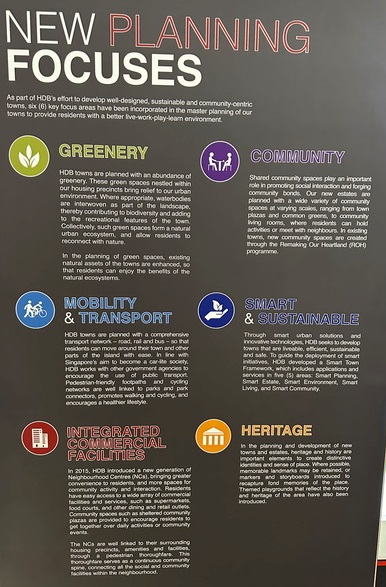

1.绿化
(Greenery)(淡宾尼北)
在组屋市镇的周边,种植更多的树木。花草也会被培植,并穿插千水道与小池间。使得城市生活更具续纷色彩和更接近大自然。
2
流动与交通
(Mobility
& Transport)(兀兰)
各组屋区及市镇之间的交通网络四通八达,无论是道路,公交车及地铁等都非常方便。为了打造减少用车的社会,建屋局与其他部门合作,鼓励大家出行时,多使用公共交通。当局也多建造行人步道,公园连道,目的是鼓励人们多步行或使用脚踏车作为代步工具。同时提倡更健康的生活方式。
3.
综合商业设施
(Integrated
Commercial
Facilities)(榜鹅绿洲广场)
2015年,建屋局推出综合性的商业发展项目。为居民提供更方便的购物,零售,餐饮及生活设施。
4.社区
(Community) (勿洛)
增设各种促进社区及种族和谐的设施,如广场,公园,大堂等。让居民有更多的交流平台。通过举办各种活动来促进居民之间的关系。
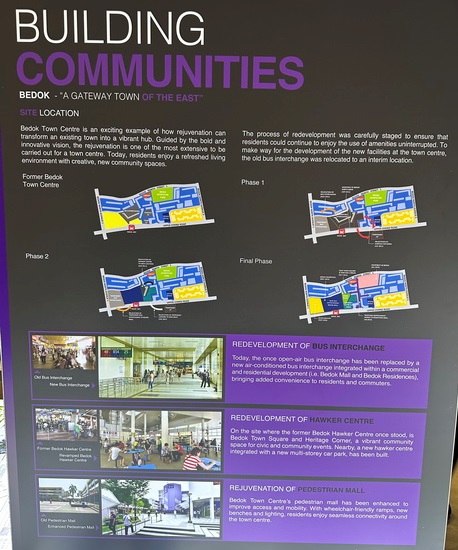
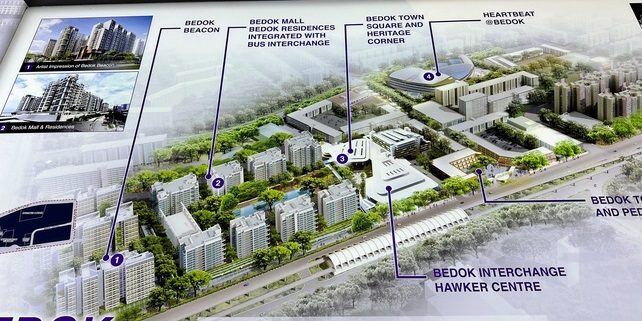
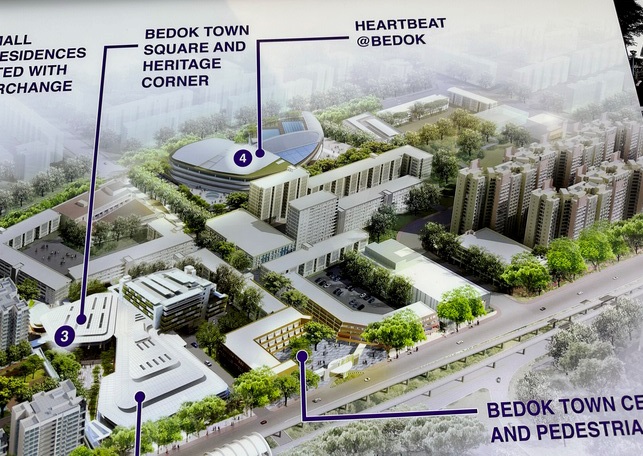
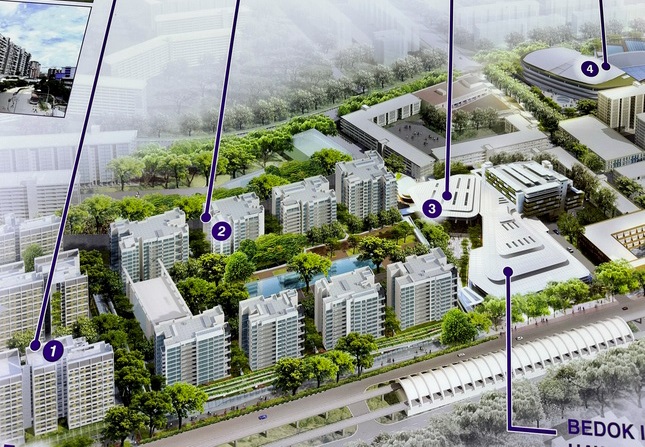
5
智能性与可持续性
(Smart&
Sustainable)
(榜鹅北岸)
 通过智能城市的建设及创新,来驱动发展。建屋局的发展规划,将使得市镇更安全,舒适与宜居。 通过智能城市的建设及创新,来驱动发展。建屋局的发展规划,将使得市镇更安全,舒适与宜居。
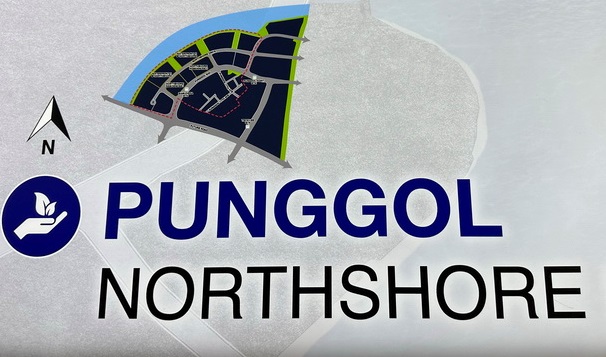
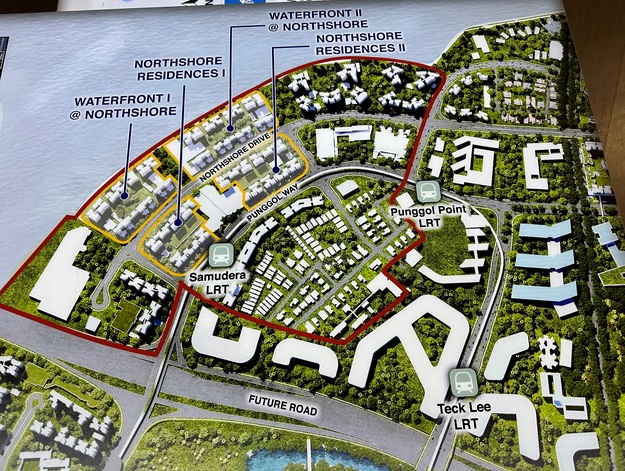
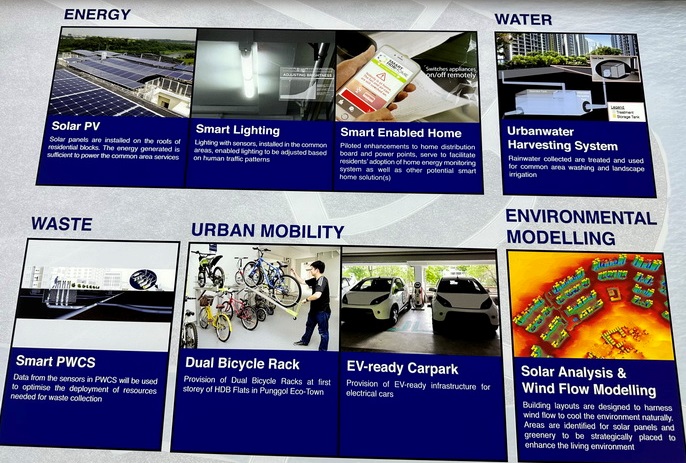

6.
文化遗产
(Heritage)
(比达达利)
在发展新镇的同时也注重保留文化遗产。很多相关的历史文化,尤其是有历史意义的事迹,将会在文化遗产地点,竖立地标或告示牌等方式,加以标识。
第三展区
(视频)生态环境
(Eco)
•
通过科技,打造市镇及永续发展,提升更优质的生活水平。
•
通过看板视频,以榜鹅为例,分别从市镇,邻里及邻区三个层次,来体现生态环境的规划与设计理念。
•
土地利用和设施建设。
•
交通网络快捷相通。
•
公园及周边配套。
•
基础设施及配套工程建设。
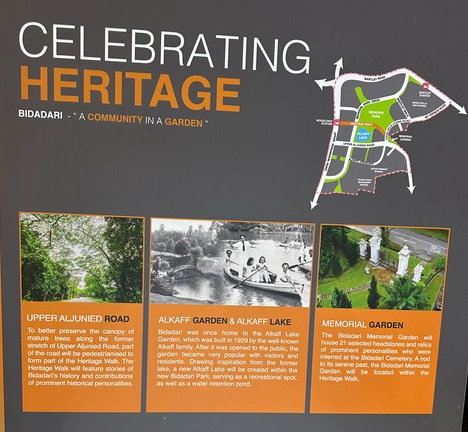
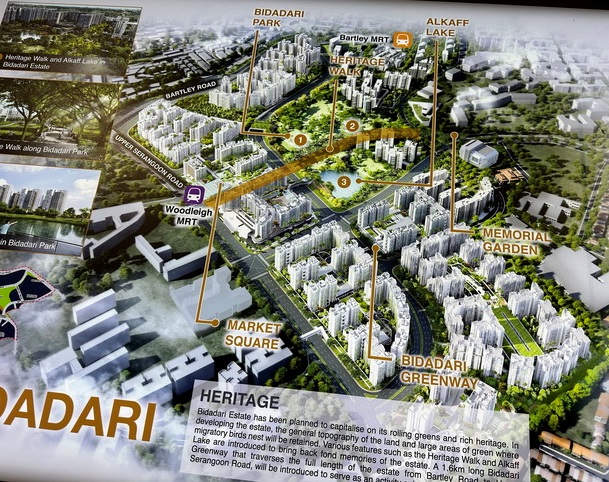
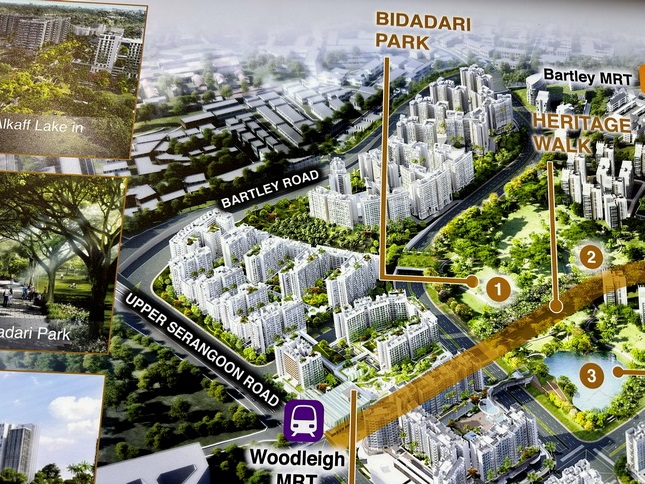
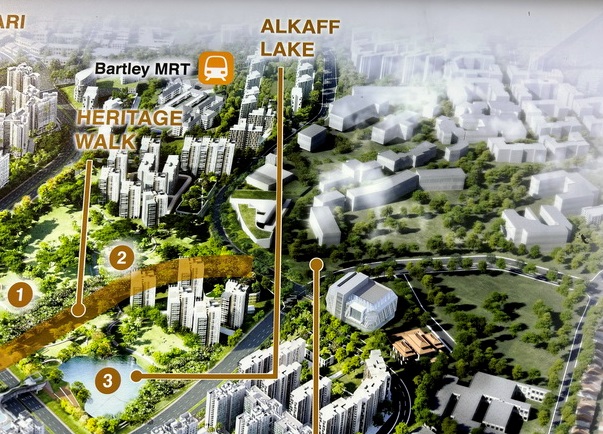
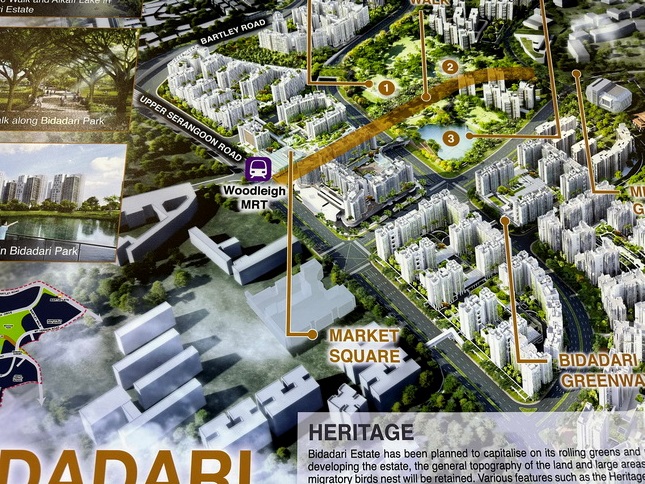
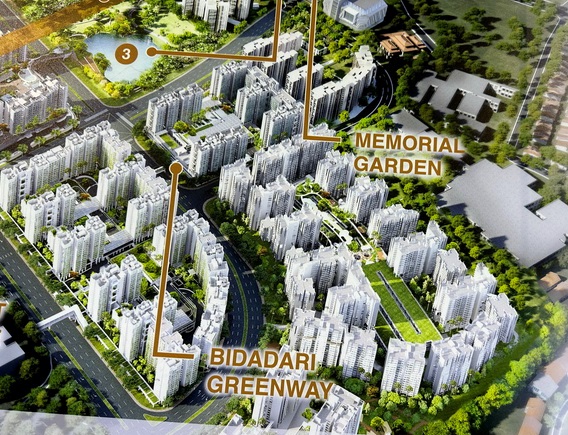

第四展区
创新
(Create)
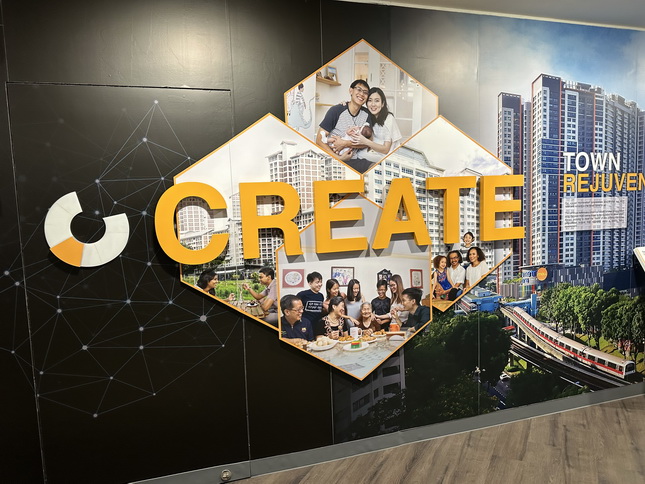
活力市镇
(Town
Rejuvenation)
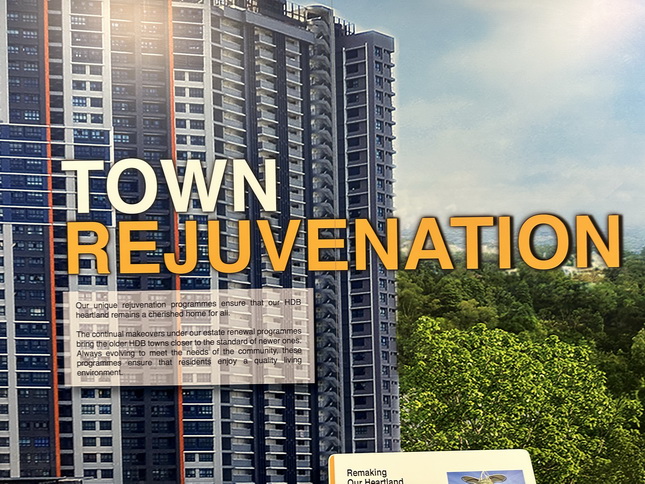
建屋局不遗余力的将旧组屋,通过重新改造工程和增加与提升各种设施。来拉近新旧组屋之间的差距。
再创我们的家园
Remarking
Our Heartland
(ROH)
•
ROH计划是—项综合计划,旨在将城镇和组屋,改造成更具活力、更令人喜爱的家园。
•
每个ROH计划都会根据其社区的需求,而量身定制。改善周边的设施和加强特色。
•
更新社区空间改造计划,居民们的参与及被咨询,发挥了关键性的作用。
选择性整体重建计划
Selective
En Bloc
RedevelopmentScheme (SERS)
•
选定的组屋将为整体重新开发而让路,以充分的利用土地,并振兴旧的住宅区。
•
居民可以选择整体搬迁到全新的组屋单位,从而保持家庭和社区的联系。
邻区更新计划
Neighborhood Renewal Program
(NRP)
注重改善街区和区域内的公共区域,让居民积极参与塑造他们的生活环境。
家居改进计划与乐龄易计划
Home Improvement Program (HIP) with
enhancement for Active Seniors
(EASE)
•
HIP帮助组屋业主,有系统地解决老化组屋所常见的维修问题。
•
EASE提供适合年长者的改进措施,打造更安全舒适的居住环境。

第五展区
分享
(Share)
从家到充满活力的社区
 除了提供住房外,建屋发展局还通过各种方式建立活跃且有凝聚力的社区。为社区提供聚会和交流的良好空间,社区计划鼓励邻居参与。 除了提供住房外,建屋发展局还通过各种方式建立活跃且有凝聚力的社区。为社区提供聚会和交流的良好空间,社区计划鼓励邻居参与。
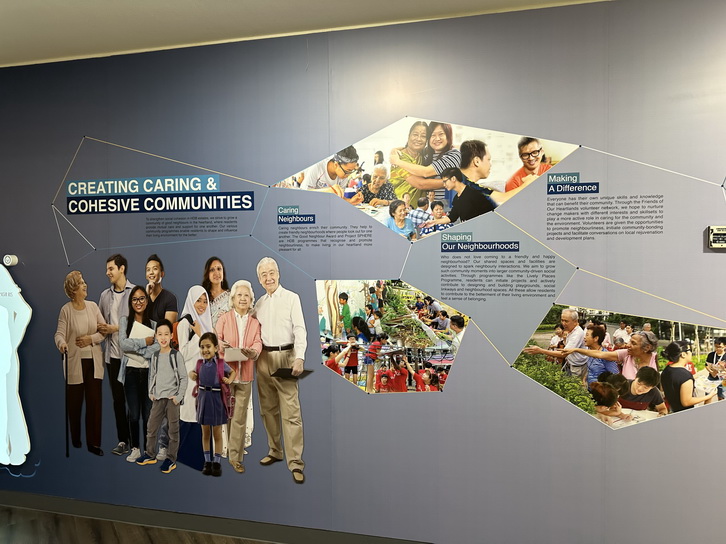
创造关爱和有凝聚力的社区
为加强社区的社会凝聚力,建屋发展局致力在市镇的中心地带,设置睦邻社区,让居民互相关心,互相支持。
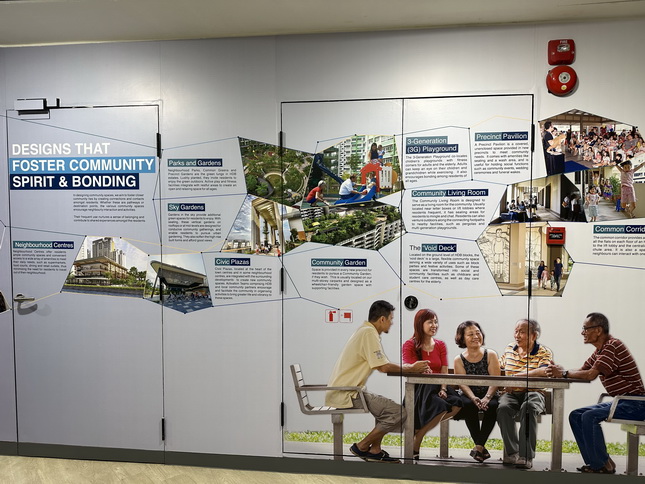
促进社区精神和凝聚力的设计
在设计社区空间时,主要的目标是通过在居民之间建立联系,来促进更紧密的社区关系。
各种设施的改善,都鼓励邻里互动和参与。

适应老龄化
到了2030年,每4个人当中,(约90万)就有1个65岁或以上的年长者。故需要提升设施和项目,以方便年长者居住。
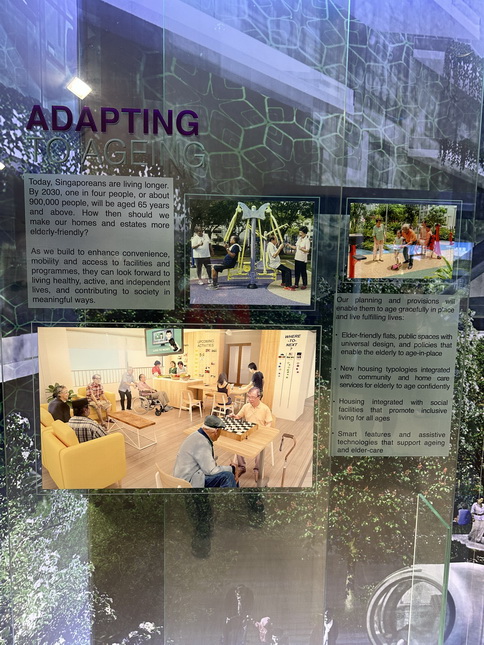
创造空间
在一个只有720平方公里的小国家里。既需要土地来应对人口增加的需要。同时,也需要保留土地来供建设机场,蓄水池,自然保护区及军事训练场地,打造宜居家园就变得越来越重要。故需以创新的方式创造空间充分的利用土地。
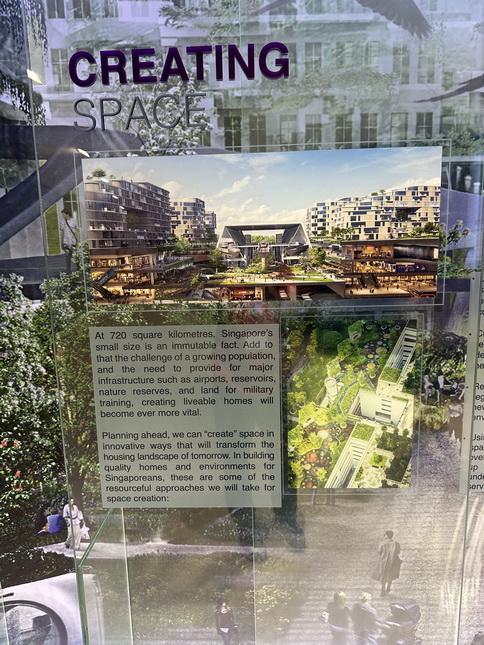
拥抱社会多样性
作为全球的枢纽,我们的社会正变得更加多元化。为反映这种丰富的多元性。在设计以社区为中心的城镇,培育强大的社区精神和认同感时,希望居民共享公共空间。
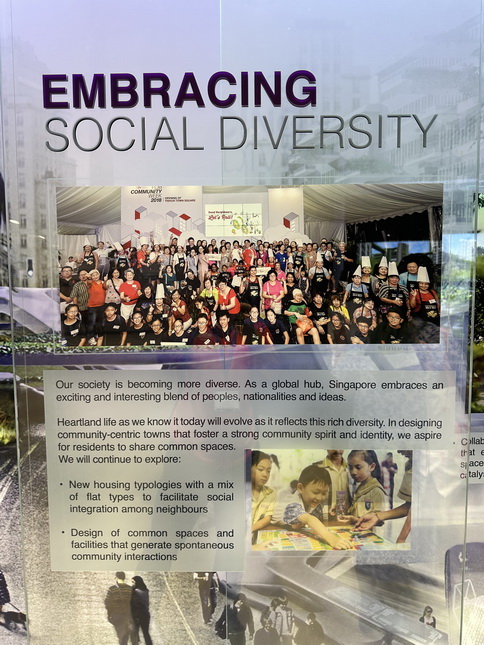
拯救我们的周遭环境
与许多其他国家—样,新加坡也面对气候变化风险及海平面上升的影响。建屋发展局需要以更可持续的方式来规划和建设。
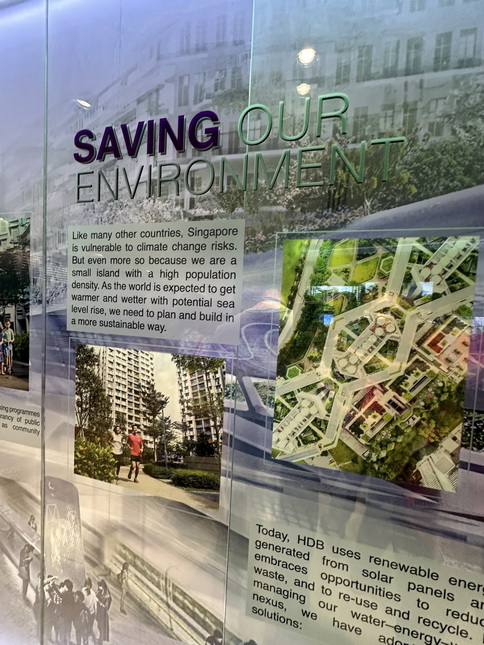
第六展区
未来发展
(Future)
随着气候变化加剧,建屋发展局利用科技,建造新—代的组屋。
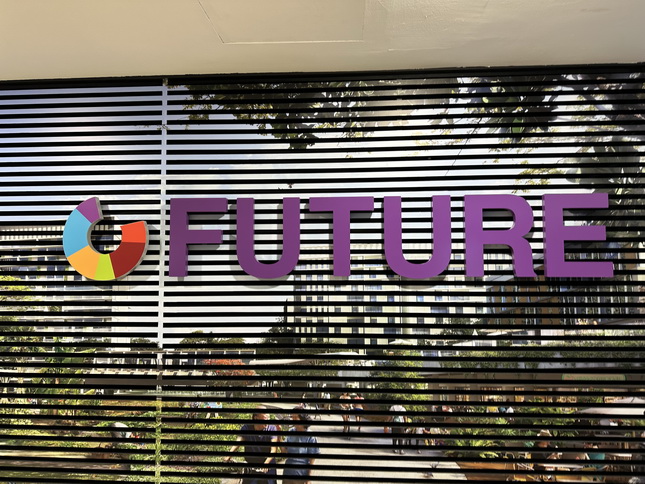
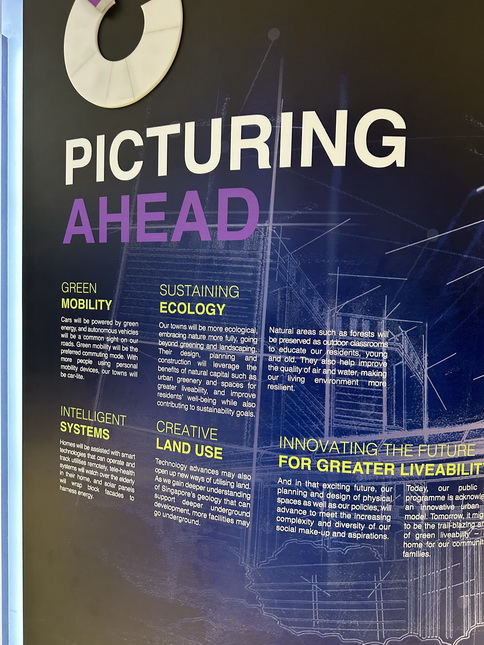
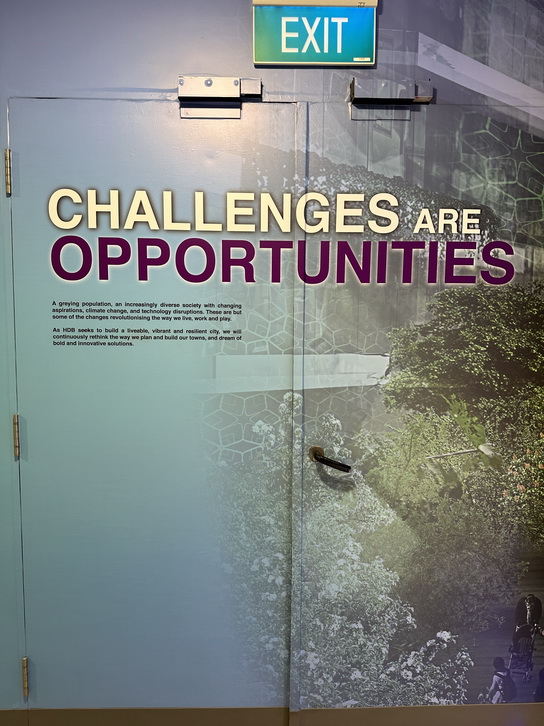
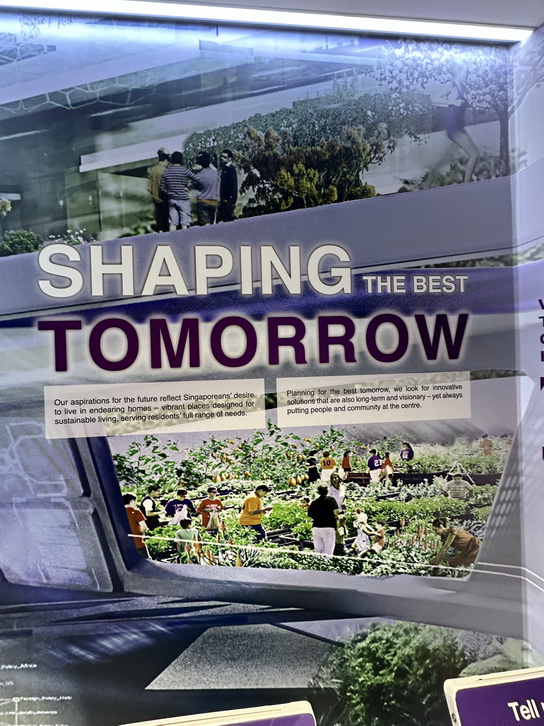
以创新打造更佳的生活素质
(Innovating
for
Better
Living)

创新
(Invent)
建屋发展局通过2009年成立的建筑研究所实验室,开发了许多新的建筑及环境工程技术,并使用这些技术来改进居民们的居住和生活环境。
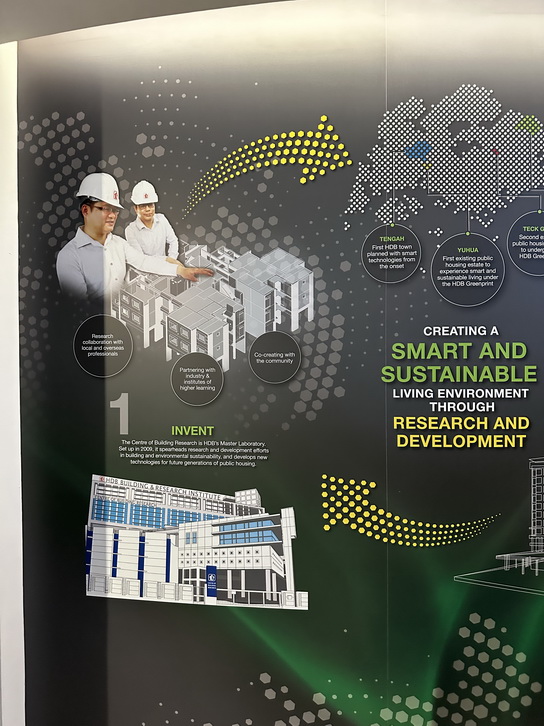
试点项目
(Pilot)
新的科技创新发展趋势,将会在一些新镇如榜鹅和登加以及旧镇如裕华和德义区实施。并将收集居民的反馈意见和建议。从中吸取经验加以改进。
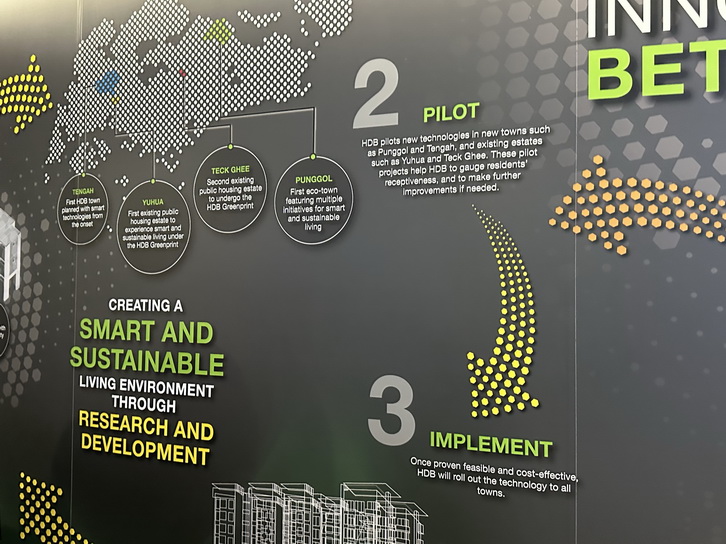
实践
(Implement)
一旦研究结果显示可行性及节省成本。就会向其他市镇推行。
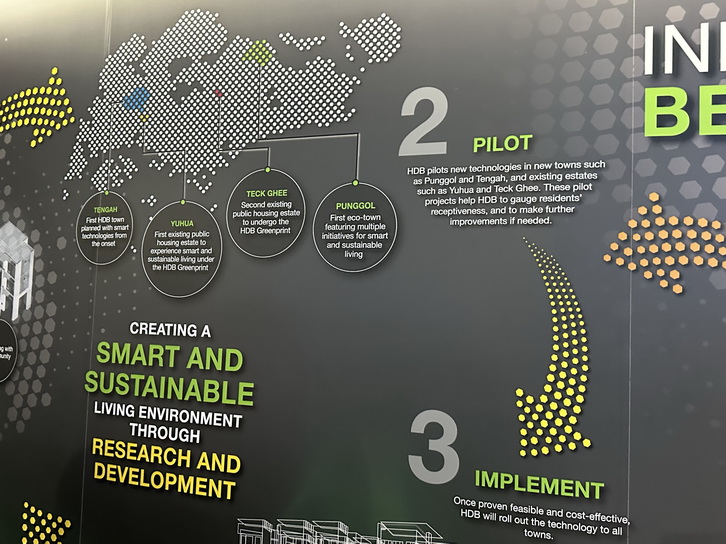
分享
(Share)
 建屋发展局会与本地及海外建筑公司分享成果,并交换心得。以提高企业发展的效益。 建屋发展局会与本地及海外建筑公司分享成果,并交换心得。以提高企业发展的效益。


第七展区
为生活而设计
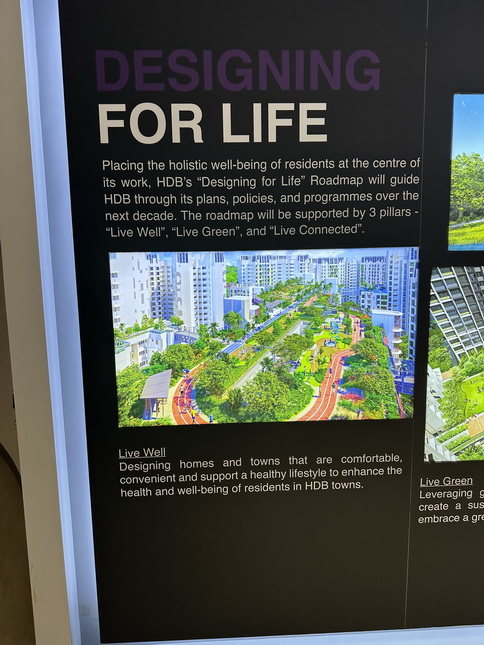
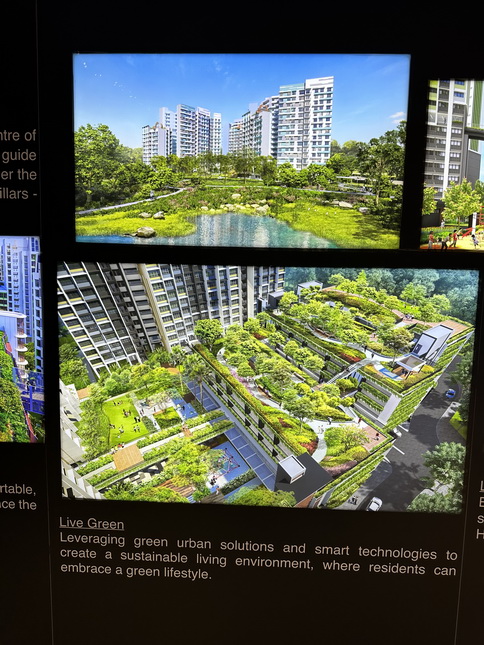
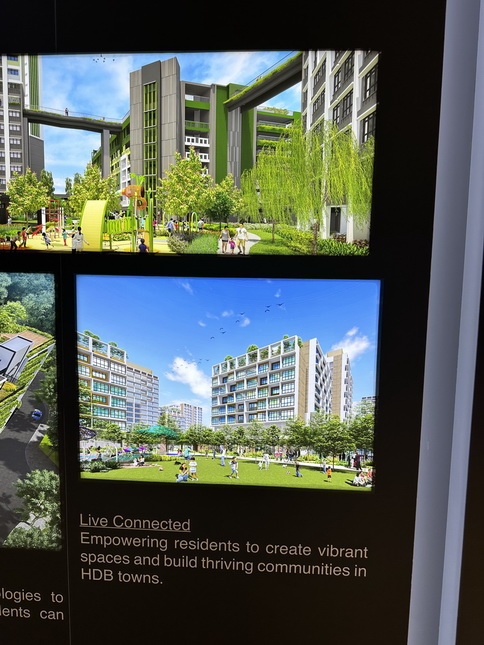
将居民的整体福扯置于工作的中心。
建屋发展局将在未来十年内制定计划,政策和方案,来设计发展路线图。
该路线图将由三大支柱支撑。优质生活、绿色生活、和谐生活。
大荧幕
(电影)
通过录制视频,介绍正在发展中的第24个建屋发展局市镇-登加市镇的规划和面貌。
大巴窑的发展历程
•
在1960年代建造的大巴窑,是建屋发展局首个推出的全新构思设计以及设备完善的市镇。
它保留了浓厚的甘榜精神,反映出新加坡的建屋发展历程。
从70年代至今,大巴窑也经过多番的改建工程。
目前已经是具有历史特色并富有代表性的市镇。
•
大巴窑镇的模型。
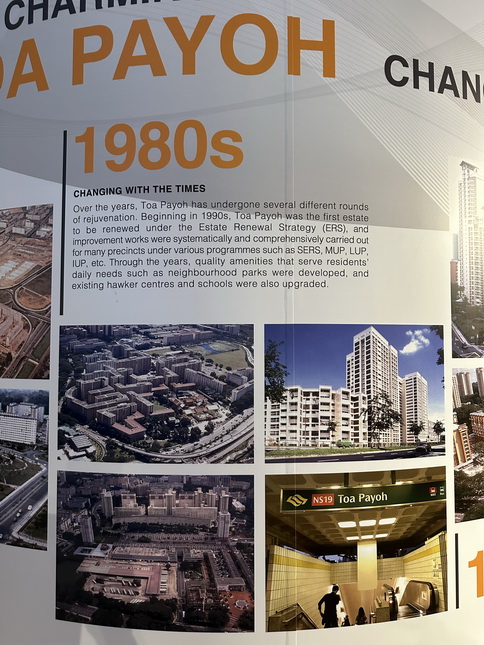
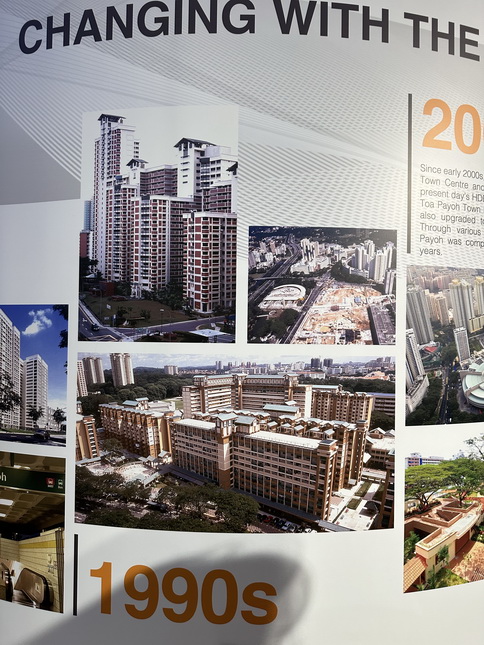
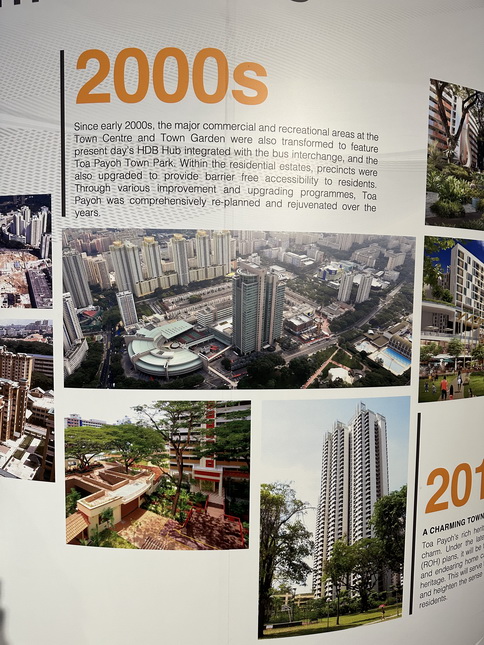
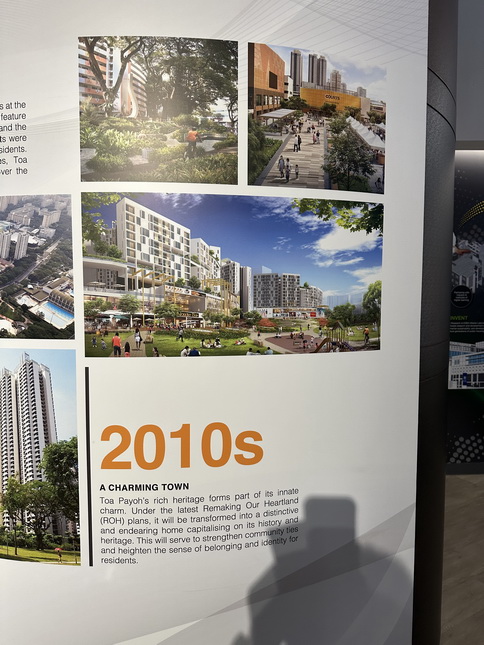
一起玩耍
新—代主题游乐场,增强游戏体验,激发想象力,培养儿童的冒险精神。家长和孩子可以—起玩耍,也加强了家庭凝聚力。
(现场的龙头滑梯模型,是取材自原来在大巴窑6巷,旧大牌28座组屋旁的游乐场地)
我们的市镇及组屋区
展示了新加坡各个市镇及组屋区的分布图人口,土地面积及发展年代。

完结篇
 |
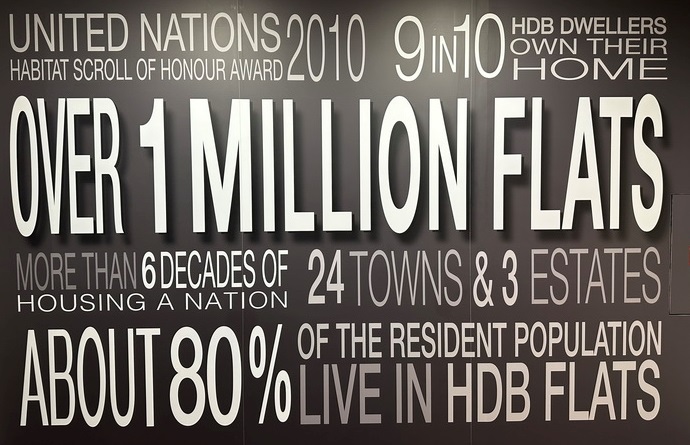
![]()



